Dushanbe
Dushanbe (Tajik: Душанбе, IPA: [duʃæmˈbe]; meaning Monday in Persian;[5][6][7] Russian: Душанбе) is the capital and largest city of Tajikistan. As of January 2020, Dushanbe had a population of 863,400 and as of 2010 that population was largely Tajik. Until 1929, the city was known in Russian as Dyushambe (Russian: Дюшамбе, Dyushambe), and from 1929 to 1961 as Stalinabad (Tajik: Сталинобод, Stalinobod), after Joseph Stalin. Dushanbe is located in the Gissar Valley, bounded by the Gissar Range in the north and east and the Babatag, Aktau, Rangontau and Karatau mountains in the south, and has an elevation of 750–900 m. The city is divided into four districts, all named after historical figures: Ismail Samani, Avicenna, Ferdowsi, and Shah Mansur.
Dushanbe
Душанбe Дюшамбе (Dyushambe, 1924–29), Сталинабад (Stalinabad, 1929–60) | |
|---|---|
Capital of Tajikistan | |
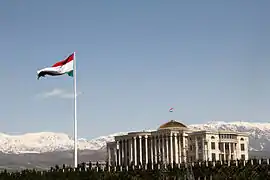 .jpg.webp)  .JPG.webp) 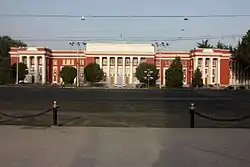   .jpg.webp) | |
 Seal | |
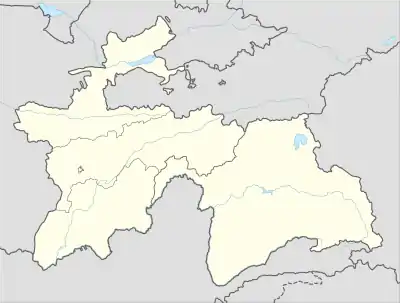 Dushanbe Location of Dushanbe in Tajikistan 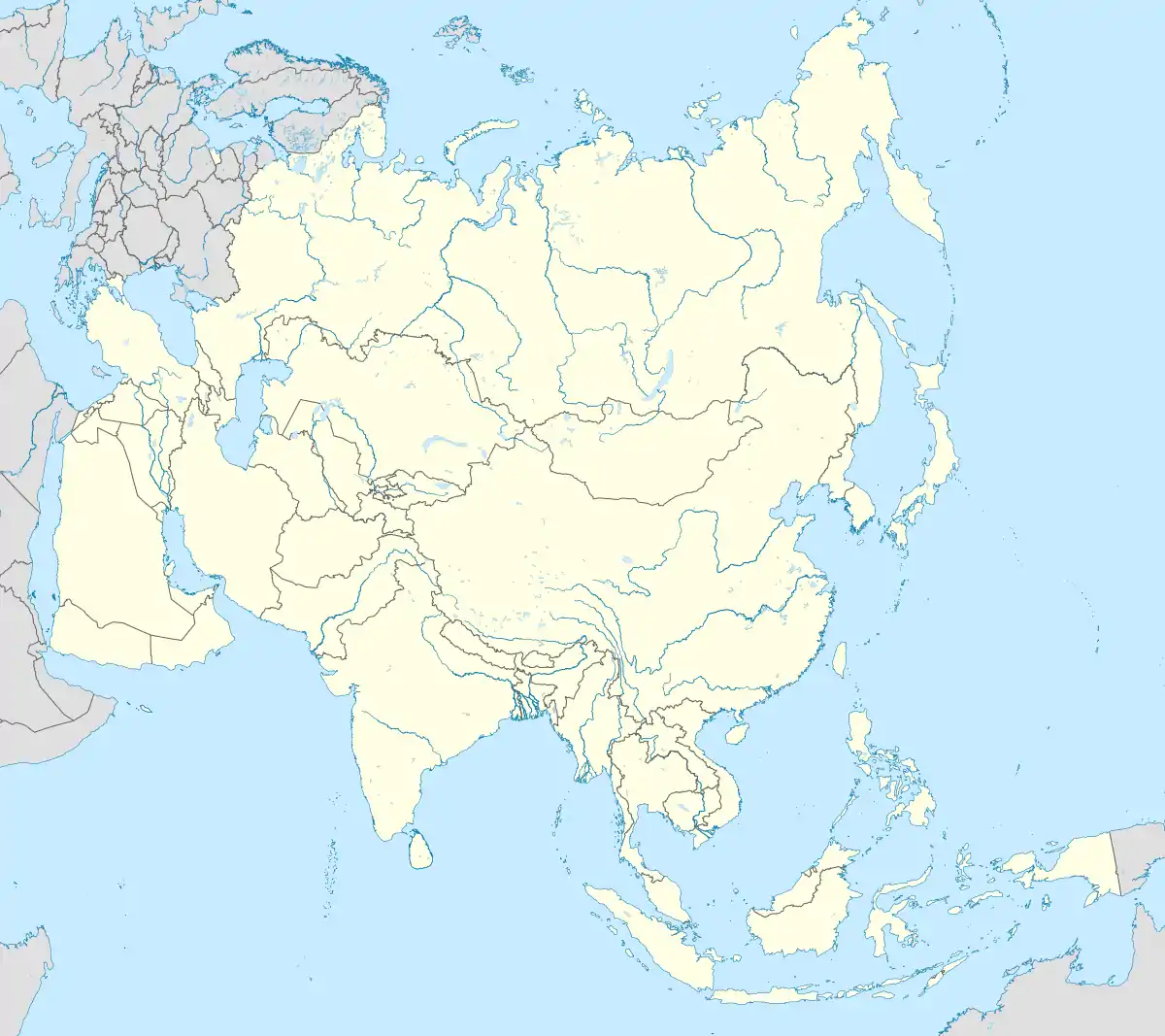 Dushanbe Dushanbe (Asia) 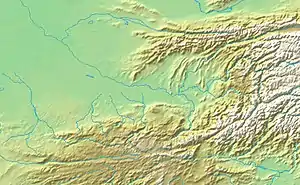 Dushanbe Dushanbe (Tokharistan) | |
| Coordinates: 38°32′12″N 68°46′48″E | |
| Country | |
| Region | Dushanbe |
| Named for | Monday |
| Districts | List
|
| Government | |
| • Mayor | Rustam Emomali (People's Democratic Party of Tajikistan) |
| Area | |
| • Land | 203.1825 km2 (78.4492 sq mi) |
| Area rank | 1 |
| Elevation | 823 m (2,700 ft) |
| Highest elevation | 900 m (3,000 ft) |
| Lowest elevation | 750 m (2,460 ft) |
| Population (1 January 2020) | |
| • Capital of Tajikistan | 863,400[3] |
| • Rank | 1 |
| • Urban density | 7,305/km2 (18,920/sq mi) |
| • Metro | 1,051,200 |
| Time zone | UTC+5 (GMT+5) |
| • Summer (DST) | UTC+5 (Tajikistan Time) |
| HDI (2017) | 0.728[4] high |
| Website | www |
In ancient times, what is now or is close to modern Dushanbe was settled by various empires and peoples, including Mousterian tool-users, various neolithic cultures, the Achaemenid Empire, Greco-Bactria, the Kushan Empire, and the Hephthalites. In the Middle Ages, more settlements began near modern-day Dushanbe such as Hulbuk and its famous palace. From the 17th century to the early 20th, Dushanbe began to grow into a market village controlled at times by the Beg of Hisor, Balkh, and finally Bukhara. Soon after the Russian invasion in 1922, the town was made the capital of the Tajik Autonomous Soviet Socialist Republic in 1924, which commenced Dushanbe's development and rapid population growth that continued until the Tajik Civil War. After the war, the city became capital of an independent Tajikistan and continued its growth and development into a modern city that today is home to many international conferences.
Dushanbe's modern culture had its beginnings in the 1920s, where Soviet music, opera, theater, sculpture, film, and sports all began. Music, primarily shashmaqam before the Soviet invasion, took off in the city due to Russian influence and local opera houses and symphonies. Tajik figures such as Sadriddin Ayni contributed greatly to the development of Dushanbe's literature, which went through many changes during and after the Soviet period. Theater and film both saw their beginnings in the 1930s and were heavily influenced by Soviet trends. The architecture of Dushanbe, once neoclassical, transitioned to a minimalist and eventually modern style. The city is a center for newspapers, radio stations, and television of the country, with almost 200 newspapers and more than a dozen television studios operating in 1999.
Much of Dushanbe's education system dates from Soviet times and has a legacy of state control; today the largest university in Dushanbe, the Tajik National University, is funded by the government. Dushanbe International Airport is the primary airport serving the city. Other forms of transport include the trolleybus system dating from 1955, the small rail system, and the roads that traverse the city. Dushanbe's electricity is primarily hydroelectric, produced by the Nurek Dam, and the aging water system dates from 1932. Tajikistan's healthcare system is concentrated in Dushanbe, meaning that the major hospitals of the country are in the city. The city makes up 20% of Tajikistan's GDP and has large industrial, financial, retail, and tourism sectors. Parks and main sights of the city include Victory Park, Rudaki Park, the Tajikistan National Museum, the Dushanbe Flagpole, and the Tajikistan National Museum of Antiquities.
Etymology
.jpg.webp)
Dushanbe was at a crossroads where a large bazaar occurred on Mondays.[7] This gave rise to the name Dushanbe-Bazar (Tajik: Душанбе Бозор, Dushanbe Bozor)[8] from Dushanbe, which means Monday in the Persian language,[6][9] literally – the second day (du) after Saturday (shambe). Its historical name of Stalinabad was named after Joseph Stalin.
History
Mesolithic
In the Stone Age, Mousterian tool-users inhabited the Gissar Valley near modern-day Dushanbe.[10]
Neolithic
The Hissar culture, Bishkent culture, and Vakhsh culture all were thought to have inhabited the Gissar Valley in the second millennium BC.[11][12] Hissar stone tools were discovered within modern-day Dushanbe at the confluence of the Varzob and Luchob.[13]
 Map of the Bishkent culture, based on a map printed at page 69 in Encyclopedia of Indo-European Culture, which was edited by J. P. Mallory and Douglas Q. Adams, and published by Taylor & Francis in 1997.
Map of the Bishkent culture, based on a map printed at page 69 in Encyclopedia of Indo-European Culture, which was edited by J. P. Mallory and Douglas Q. Adams, and published by Taylor & Francis in 1997.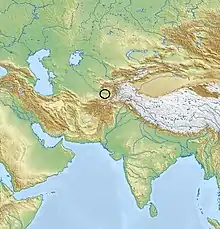 Map of the Vakhsh culture, based on a map printed at page 617 in Encyclopedia of Indo-European Culture, which was edited by J. P. Mallory and Douglas Q. Adams, and published by Taylor & Francis in 1997.
Map of the Vakhsh culture, based on a map printed at page 617 in Encyclopedia of Indo-European Culture, which was edited by J. P. Mallory and Douglas Q. Adams, and published by Taylor & Francis in 1997.
Bronze Age
Near the Dushanbe airport, Bronze Age burials were discovered dating from the end of the second to the beginning of the first millennium BC.[14]
Achaemenid period
Achaemenid dishes and ceramics were found 6 kilometers east of Dushanbe in Qiblai.[15] Archaeological remnants of a small citadel dating to the 5th century BC have been discovered 40 kilometers south[16] and wedge-shaped copper axes have been discovered from the 2nd century BC.[17]
Greco-Bactrian period

Another settlement throughout the region's early history was a small Greco-Bactrian settlement from the end of the 3rd century BC of about 40 hectares in modern-day Dushanbe.[18][17][19] The oldest coin found in Dushanbe is a Greco-Bactrian coin depicting Eucratides.[20]
Kushan period
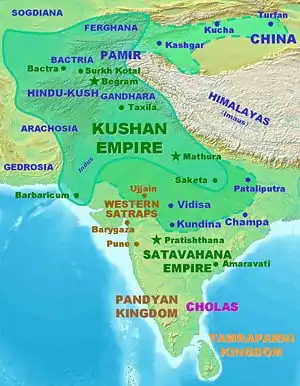
Near Dushanbe, there was also a Kushan city on the left bank of the Varzob river from the 2nd century BC to 3rd century AD containing burial sites from the time period.[21][17][19] Kushan settlements such as Garavkala, Tepai Shah, Shakhrinau, and Uzbekontepa were founded in this period near Dushanbe.[22][23]
Hephalite and Tokharistan period
Ajina Teppe was a Buddhist monastery of the Hephalite period of the late 5-6th century discovered in the Vaksh valley near Dushanbe.[24] Other settlements were discovered near Dushanbe during the Tokharistan period as well, like the town of Shishikona that was destroyed during the Soviet era and depopulated during the Mongol invasion.[25][26] International trade began during this period in the Dushanbe region.[27] A castle was also discovered in modern-day Dushanbe dating from the time period.[28] In the 7th century, a Chinese pilgrim visited the region and mentioned the city of Shuman, possibly on the site of modern Dushanbe.[29][30]
Early Middle Ages
Sasanid silver coins were discovered in the city.[17] After the Arab conquest, in the 10th-12th centuries the medieval city of Hulbuk was developed near Dushanbe, which notably contained the palace of the governor of Khulbuk, "an artistic treasure of the Tajik people," among other smaller medieval settlements like Shishikhona.[31] Kharakhanid coins were found that were minted from 1018 to 1019 in Dushanbe.[32]
Late Middle Ages
Other, smaller settlements were found from the Late Middle Ages after the Mongol invasion. These included Abdullaevsky and the Shainak settlement. The region of Dushanbe was controlled during this time period by different empires, including the Timurid Empire.[33]
Market town
The first time Dushanbe appeared in the historical record, in a letter sent from the Balkh khan Subhonquli Bahodur to Fyodor Alekseevich, the Tsar of Russia, was in 1676, referred to as "Kasabai Dushanbe," when the village was under the control of Balkh. However, the Dushanbe area was mentioned by the Balkh historian Mahmud ibn Wali in the 1630s in the book "Sea of Secrets Regarding the Values of the Noble."[34][35][36] This reflected Dushanbe's status as a town, originally taking the name Dushanbe (Monday) due to the large bazaar in the village that operated on Mondays. Dushanbe's location between the caravan routes heading east–west from the Hissar Valley through Karategin to the Alay Valley, and north–south to the Kafirnigan River and then to Vaksh Valley and Afghanistan through the Anzob Pass from the Fergana and Zeravshan valleys that ultimately led traders to Bukhara, Samarkand, the Pamirs, and Afghanistan incentivized the development of its market.[17][5][37] At the time, the town had a population of around 7-8 thousand with around 500-600 households.[38]
_(cropped_on_Central_Asia%252C_Tajikistan%252C_Uzbekistan).jpg.webp)
By 1826, the town was called Dushanbe Qurghan (Tajik: Душанбе Қурғон, Dushanbe Qurghon, with the suffix qurƣon from Turkic qurğan, meaning "fortress") Russified as Dyushambe (Дюшамбе). The first map showing the name of Dyushambe was drafted in 1875. It had a caravanserai, a stopping point for travelers to Samarkand, Khujand, Kulob and the Pamirs. It boasted 14 mosques, 2 madrassas, and 14 teahouses at the turn of the century. At that time, the town was a fortress on a steep bank on the left bank of the Varzob River with 10,000 residents.[39][38][40] It was also a center for weaving, tanning, and iron smelting production in the region. Control over it was long exercised by the Beg of Hisor but in 1868, it was given to the Emir of Bokhara by the Tsarist government.[41] The first hospital in the village was constructed in 1915 by Russian investment[42] and an early railroad was proposed to connect the market town in 1909, but was abandoned after a review determined the venture would not be profitable.[43]
In 1920, the last Emir of Bukhara briefly took refuge in Dushanbe after being overthrown by the Bolshevik revolution. He fled to Afghanistan after the Red Army conquered the area the next year, 4 March 1921.[44][45] In February 1922, the town was taken by Basmachi troops led by Enver Pasha after a siege,[44] but on 14 July 1922 again came under the power of the Bolsheviks[46][47] soon before the death of Enver Pasha on 4 August 1922 outside of Dushanbe.[44][48] It was a part of the Bukharan PSR until the formation of the Tajik ASSR.[49]
Capital of the Tajik ASSR
Dushanbe was proclaimed the capital of the Tajik Autonomous Soviet Socialist Republic as a part of the Uzbek Soviet Socialist Republic in October 1924 and the government started to function formally on 15 March 1925.[50][51][41] The population during the struggle declined from an already meager 3140 in 1920 to only 283 in 1924.[41][43]
To aid in the recovery, the Soviet authorities temporarily exempted much of the population from having to pay taxes. On 12 August 1924 the first newspaper of the village, Voice of the East, was published in Arabic and soon after a Russian-language paper, Red Tajikistan, began publication. Power plants and electricity were introduced to Dushanbe during this time. In 1924 the first regular plane route began from Dushanbe to Bukhara and another from Dushanbe to Tashkent, and the post office was set up.[43] In 1923, the Soviets created Dushanbe's first telegraph link to Bukhara, initiated its first railroad to Termez,[41] and set up a telephone switchboard in 1924.[52] Construction on the railroad began on 24 June 1926, and it was completed in November 1929, connecting Dushanbe with the Trans-Caspian railroad and kickstarting economic growth.[35] In 1925, the first boy's boarding school was constructed in the capital.[43] On 1 September 1927, the first pedagogical college opened in Dushanbe and in November the motor road from Dushanbe to Kulob was completed.[51] Tajiks from the countryside were given assistance and free land plots in the capital to increase its population and development.[43]
Capital of the Tajik SSR
A Tajik Soviet Socialist Republic separate from the Uzbek SSR was created in 1929, and its capital Dyushambe was renamed Stalinabad (Russian: Сталинабад; Tajik: Сталинобод Stalinobod) for Joseph Stalin on 19 October 1929, which incorporated the nearby villages of Shohmansur, Mavlono, and Sari Osiyo.[35][53][51]
Reasons for selection
_-_not_so_busy.svg.png.webp)
Dushanbe was chosen instead of larger-populated villages in Tajikistan because of its role as a crossroads of Tajikistan for its large market served as a meeting place for much of Tajikistan's population. Along with its market, there was a lively livestock trade as well as trade in fabrics, leather, tin products, and weapons.[54]
Dushanbe also boasted the only Jewish population in the Tajik SSR, whom were involved in trade and in loaning money, financing much of the Red Army during its conquest of the region.[43] When the Emir moved to the city, however, the Jewish population's property was plundered and the Jews were relocated to Hisor. They were only let back into Dushanbe with its conquest by the Red Army.[55]
The mild Mediterranean climate was another reason Soviet authorities chose the city as the capital.[43]
Dushanbe was also officially recognized as the capital of the Emirate of Bukhara during its waning days as it served as the last refuge of the last Emir of Bukhara during its conquest by the Soviet Union, possibly another motivating factor for the decision to establish the new ASSR's capital in the village.[54]
Later development
In the years that followed, the city developed at a rapid pace.[17] The Soviets transformed the area into a center for cotton and silk production, and tens of thousands of people relocated to the city. The population also increased with thousands of ethnic Tajiks migrating to Tajikistan from Uzbekistan following the transfer of Bukhara and Samarkand to the Uzbek SSR as part of national delimitation in Central Asia.[48] Industry during the time period was limited, focused on local production.[41] The first bus line began operating in 1930 and in 1940 Komsomolskoye Lake was constructed in the city.[43]
Many of these projects occurred under the mayoralty of Abdukarim Rozykov, one of the first mayors of Dushanbe, from 1925 to 1932, who sought to transform it into a "model communist city" through modernization and urban planning. Mikhail Kalitin continued the industrial development of Dushanbe, building the Komsomolskoye Lake and promoting industry in the city.[56] Towards the end of this period, in the late 1930s, there were 4,295 buildings in Dushanbe.[57]
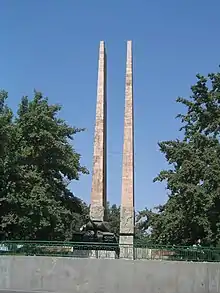
During World War 2, the population of Dushanbe and Tajikistan swelled with 100,000 evacuees from the front that led to the deployment of 17 hospitals in the city.[54] The city's industry also greatly increased during the war, as the Soviets wanted to move critical infrastructure far behind enemy lines, and industries like textile manufacturing and food processing began to grow.[41] In 1954, there were 30 schools in the city, a medical institute named after Avicenna, the Stalinabad Academy of Sciences, the University of Stalinabad, which was founded in 1947 and had 1,500 students,[58] and the Stalinabad Pedagogical Institute for Woman, established on 1 September 1953.[59] In 1960, gas supply reached the capital through a gas pipeline opened from Kyzyl to Tumxuk to Dushanbe. On 10 November 1961, as part of de-Stalinization, Stalinabad was renamed back to Dushanbe, the name it retains to this day.[60] In the 1960s, under the leadership of Mahmudbek Narzibekov, the first zoo was built in the city along with a plan to end the housing shortage and provide free apartments.[56]
The Nurek Dam, which would have been the tallest dam in the world, was completed 90 kilometers south east of Dushanbe during that time period. The Rogun Dam, upstream from Nurek Dam, was started in the period as well. They were both megaprojects meant to showcase Soviet innovation and development in Tajikistan, but while the Nurek Dam was completed the Rogun Dam was cancelled in the 1970s because of stagnating Soviet economic growth.[61][62] On 2 August 1979 the population of Dushanbe reached 500,000.[51]
Riots and unrest
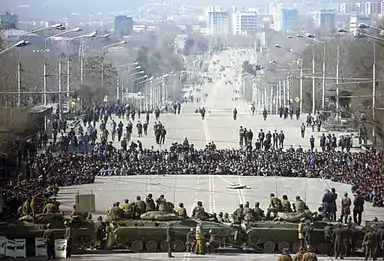
In the 1980s, environmental problems and crime began to increase. Mass violence, hooliganism, binge drinking, and violent assaults were becoming more common in Dushanbe. There was an attack on foreign students at the Agricultural Institute in 1987 and a riot in the Pedagogical Institute two years later.[63] Increasing regionalism also destabilized the SSR.
On 10–11 February 300 demonstrators gathered at the Communist Party Central Committee building after it was rumored that the Soviet government planned to relocate tens of thousands of Armenian refugees to Tajikistan. In reality, only 29 Armenians went to Dushanbe and were housed by their family members. However, the crowd kept growing in size to 3 to 5 thousand people until violence began in the city. Martial law was quickly declared and troops were sent in to protect ethnic minorities and defend against vandalism and looting. The number of people protesting increased significantly, however, and they attacked the Central Committee building. The 29 Armenians were quickly evacuated on an emergency flight after shots were fired.[64]
A few days after, and with looting still occurring throughout the city, demonstrators created the Provisional People’s Committee, or the Temporary Committee for Crisis Resolution, which put forward demands such as "the expulsion of Armenian refugees, the resignation of the government and the removal of the Communist Party, the closure of an aluminum smelter in western Tajikistan for environmental reasons, equitable distribution of profits from cotton production, and the release of 25 protesters taken into custody."[64]
Many high-ranking officials resigned, and the protector's goal of toppling the government was close to being successful, but Soviet troops moved into the city, declared the demands illegal, and rejected the resignation of the high-ranking officials. 16-25 people were killed in the violence and many if not most were Russian.[64]
The riots were largely fueled by concerns about housing shortages for the Tajik population, but they coincided with a wave of nationalist unrest that swept Transcaucasia and other Central Asian states during the twilight of Mikhail Gorbachev's rule.[65]
After the increase of organized opposition from the Democratic Party of Tajikistan and Rastokhez, glasnost by Gorbachev, economic contraction, and increased opposition by regional elites, Qahhor Mahkamov disbanded the Communist Party of Tajikistan on 27 August 1991 and quit the party the next day. On 9 September 1991 Tajikistan's government declared independence from the Soviet Union.[66]
Capital of Tajikistan
Dushanbe became the capital of an independent Tajikistan on 9 September 1991.[66]
Tajikistani Civil War
On 24 November 1991 Rahmon Nabiev was elected President of Tajikistan, defeating Davlatnazar Khudonazarov soon after Tajikistan declared independence. Iran, the United States, and Russia soon opened embassies in Dushanbe. Nabiev was soon forced to resign before the government abolished the office of president and chose Emomoli Rahmon as head of state; in 1994 the office of president was re-established with Rahmon chosen to be president once again.[51] Dushanbe was controlled by the Russian-backed government during most of the Tajikistani Civil War, although the Islamist and Democratic United Tajik Opposition managed to capture the capital in 1992 before 8000 Russian-backed and Uzbekistani-backed government troops regained control of Dushanbe.[67] Most of the Russian population fled the capital during the violence of this time period while large amounts of rural Tajiks moved in; by 1993, more than half had fled.[35][68] The factions during the civil war were organized primarily upon regional lines.[67] The war was ended by a 27 June 1997 armistice, administered by the UN, that guaranteed the opposition 30% of the positions in the government.[69]

Modern day
In 2000, Dushanbe received internet access for the first time.[51] In 2004, the UNESCO declared Dushanbe as a city of peace.[70] Mahmadsaid Ubaidulloev was declared mayor of Dushanbe in 1996, after during the civil war era many said he was in real control of the government.[71] He was the mayor of the capital for the longest term of any mayor, of 21 years, until 2017.[56] From independence, the city's economy has grown consistently up to the COVID-19 recession.[72][73]
In January 2017, Rustam Emomali, current President Emomali Rahmon's son, was appointed Mayor of Dushanbe, a move which is seen by some analysts as a step to reaching the top of the government.[74]
Geography
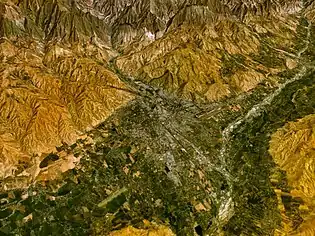
Dushanbe is situated at the confluence of two rivers, the Varzob (flowing from north to south) and Kofarnihon, 750–930 meters above sea level. In the south and west, the elevation is closer to 750–800 meters, while in the north and northeast it reaches 900–950 m. The north and east of the city is bounded by the Gissar range, which can reach up to 4000 m above sea level, and is bounded on the south by the Babatag, Aktau, Rangontau and Karatau mountains which reach a height from 1400 to 1700 m above sea level; Dushanbe, therefore, is an intermontane basin.[17] It has a primarily hilly terrain. 80% of Dushanbe's buildings are located within its valley, which has a width of approximately 18 km up to 100 km.[75][76] Before the 60s, most of Dushanbe was located on the left bank of the Varzob river, but increased construction led to the city expanding across it.[77]
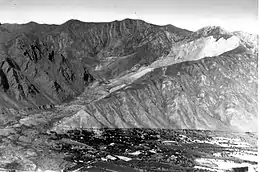
Dushanbe is also located in an area with high seismicity. The magnitude of earthquakes is predicted to be a maximum of 7.5-8. Over the past 100 years, many earthquakes from a 5-6 magnitude have been felt in the city, such as the 1949 Khait earthquake.[77]
Climate
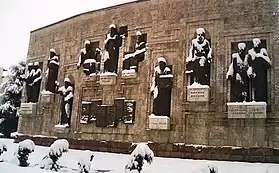
Dushanbe features a Mediterranean climate (Köppen: Csa),[78] with some humid continental climate influences (Köppen: Dsa) due to the nearby glaciers and mountain range.[17][78] The summers are hot and dry and the winters are chilly, but not very cold. The climate is damper than other Central Asian capitals, with an average annual rainfall over 500 millimetres (20 in) as moist air is funneled by the surrounding valley during the winter and spring. Winters are not as cold as further north owing to the shielding of the city by mountains from extremely cold air from Siberia. January 2008 was particularly cold, and the temperature dropped to −22 °C (−8 °F).[79] Snow cover occurs for an average of 25 days a year and cloudy days make up an average of 24 a year.[77]
Winter in Dushanbe begins on 7 December and ends on 22 February; spring starts on 22 February and ends on 17 May. During springtime, cyclones and rain are at their highest along with thunderstorms and hail, which causes significant damage and occurs for around 3 days per year.[77] Summer starts on 17 May and ends on 14 August. Dry weather sets in during this, as evidenced by a sharp drop in precipitation during the summer. A warm and dry autumn begins on 14 August and ends on 7 December.[75]
| Climate data for Dushanbe (1981–2010, extremes 1926–present) | |||||||||||||
|---|---|---|---|---|---|---|---|---|---|---|---|---|---|
| Month | Jan | Feb | Mar | Apr | May | Jun | Jul | Aug | Sep | Oct | Nov | Dec | Year |
| Record high °C (°F) | 21.8 (71.2) |
27.7 (81.9) |
32.2 (90.0) |
35.3 (95.5) |
38.8 (101.8) |
43.0 (109.4) |
43.7 (110.7) |
45.0 (113.0) |
38.9 (102.0) |
36.8 (98.2) |
31.9 (89.4) |
24.3 (75.7) |
45.0 (113.0) |
| Average high °C (°F) | 8.6 (47.5) |
10.5 (50.9) |
15.9 (60.6) |
22.3 (72.1) |
27.3 (81.1) |
33.1 (91.6) |
35.8 (96.4) |
35.2 (95.4) |
30.7 (87.3) |
23.9 (75.0) |
17.3 (63.1) |
10.9 (51.6) |
22.6 (72.7) |
| Daily mean °C (°F) | 3.0 (37.4) |
4.8 (40.6) |
9.9 (49.8) |
15.7 (60.3) |
20.1 (68.2) |
25.3 (77.5) |
27.5 (81.5) |
26.2 (79.2) |
21.1 (70.0) |
14.7 (58.5) |
9.7 (49.5) |
4.9 (40.8) |
15.2 (59.4) |
| Average low °C (°F) | −1.0 (30.2) |
0.4 (32.7) |
5.1 (41.2) |
10.0 (50.0) |
13.6 (56.5) |
17.5 (63.5) |
19.3 (66.7) |
17.6 (63.7) |
12.8 (55.0) |
7.8 (46.0) |
4.4 (39.9) |
0.8 (33.4) |
9.0 (48.2) |
| Record low °C (°F) | −26.6 (−15.9) |
−17.6 (0.3) |
−12.9 (8.8) |
−6.1 (21.0) |
1.2 (34.2) |
8.4 (47.1) |
10.9 (51.6) |
8.2 (46.8) |
−1.0 (30.2) |
−4.4 (24.1) |
−13.5 (7.7) |
−19.5 (−3.1) |
−26.6 (−15.9) |
| Average precipitation mm (inches) | 67 (2.6) |
89 (3.5) |
111 (4.4) |
98 (3.9) |
67 (2.6) |
13 (0.5) |
4 (0.2) |
0.9 (0.04) |
5 (0.2) |
31 (1.2) |
41 (1.6) |
67 (2.6) |
592 (23.3) |
| Average precipitation days (≥ 1.0 mm) | 8.5 | 9.1 | 13.4 | 9.8 | 7.8 | 1.5 | 0.7 | 0.1 | 0.8 | 3.7 | 5.3 | 8.1 | 68.8 |
| Average relative humidity (%) | 69 | 67 | 65 | 63 | 57 | 42 | 41 | 44 | 44 | 56 | 63 | 69 | 57 |
| Mean monthly sunshine hours | 120 | 121 | 156 | 198 | 281 | 337 | 352 | 338 | 289 | 224 | 164 | 119 | 2,699 |
| Source 1: Pogoda.ru.net[80] | |||||||||||||
| Source 2: Deutscher Wetterdienst (humidity 1951–1993 and precipitation days 1961–1990)[81] NOAA (sun, 1961–1990)[82] | |||||||||||||
Flora and fauna

Before the 20th century, the city had some vegetation due to the semi-savanna climate such as bushes of Bukhara almonds, but the creation of the city mostly removed natural vegetation. The green line, however, and the botanical garden introduced new vegetation to the city and today Dushanbe is one of the greenest capitals in Central Asia, with over 150 species of trees and shrubs, with only about 15 native to the city[77] and 22% of the city being occupied by green space.[83]
There are 14 species of mammals in urban Dushanbe, including five rodents, foxes, and bats. There are 130 bird species in the city, such as rock pigeons, blue pigeons, and turtle doves. Migratory birds are common, often staying only in fall and summer. There are 47 reptiles in Dushanbe, such as geckos, snakes, lizards, and turtles. Amphibians, like the marsh frog and the green toad, live in the cleaner water bodies of the city. The 14 fish species of Dushanbe live in the rivers, lakes, and ponds of the city. Some species are the marinka, the Tajik char, and the Turkestan catfish in the Varzob rivers, along with 7 in the Kofarnikhon, and species like carp, goldfish, striped swine, and mosquito fish in the lakes and ponds. 300 insects inhabit the city, mostly cicadas, psyllids, aphids, scale insects, bugs, beetles, and butterflies. The endemic Hissar grape hawk moth lives in the city as well, and malaria carrying insects have been increasing in the city. Phytonematodes are a menace to plants in the city, with 55 distinct species, the most damaging of which are the root gall nematodes. Rare or endangered species include the radiant tachysphex, the white-bellied arrow eagle, and the European free-tailed bat.[77]
Districts
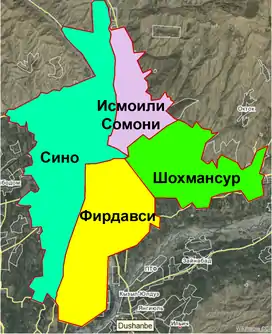
Dark Green: Shah Mansur
Purple: Ismail Samani
Light Green: Avicenna
Yellow: Ferdowsi
Dushanbe is divided into the following districts:
| District name | Former name | Area, | Population,
persons (as of previous 2019 borders)[84] |
District Chairman[85] |
|---|---|---|---|---|
| Ismail Samani (Tajik: Исмоили Сомонӣ, Ismoili Somoni; Persian: اسماعیل سامانی) | October (Октябрьский) | 37.6 | 148,700 | Sami Sharif Hamid |
| Avicenna (Sino) (Tajik: Абӯалӣ Ибни Сино, Abūali Ibni Sino; Persian: ابوعلی ابن سینا) | Frunzensky (Фрунзенский) | 62.2 | 326,100 | Salimzoda Nusratullo Faizullo |
| Ferdowsi (Tajik: Фирдавсӣ, Firdavsi; Persian: فردوسی) | Central (Центральный) | 54.5 | 209,000 | Yusufi Muhammadrahim |
| Shah Mansur (Tajik: Шоҳмансур, Shohmansur; Persian: شاه منصور)[2] | Railway (Железнодорожный) | 48.9 | 162,600 | Bilol Ibrohim |
Land use
.jpg.webp)
| Land | Area (ha)[1] |
|---|---|
| Irrigated land | 2,091.75 |
| Orchards | 145.21 |
| Silk gardens | 12.28 |
| Citrus orchards | 2.10 |
| Pastures | 25.79 |
| Settlements | 6390.85 |
| Private farms/gardens | 65.79 |
| Swamp | 3.7 |
| Bush thickets | 1372.0026 |
| Reservoirs | 1436.66 |
| Underground passages | 310.2 |
| Construction | 7227.51 |
| Land not used for agriculture | 1235.03 |
Main sights
Some of Dushanbe's major sights include the Tajikistan National Museum, the National Museum of Antiquities, the Ismaili Centre, Vahdat Palace, the Dushanbe Flagpole, which is the second tallest free-standing flagpole in the world, at a height of 165 metres (541 feet),[86] the Dushanbe Zoo, Rudaki Avenue, the main street of the capital, the Gurminj Museum of Musical Instruments, and the National Library, the largest in Central Asia.[5][87]
- Main sights of Dushanbe
.jpg.webp)
 Puppet Theater
Puppet Theater.jpg.webp)
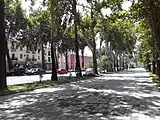 Rudaki Avenue
Rudaki Avenue
Demographics
The average life expectancy of Dushanbe in 2014 was 74.1 years overall, with 71.9 years for men and 76.3 for women. From 2005 to 2014, 53,118 thousand people migrated to the city.[72]
| Year | Pop. | ±% |
|---|---|---|
| 1676[38] | 7,500 | — |
| 1875[38] | 10,000 | +33.3% |
| 1920 | 3,140 | −68.6% |
| 1924[41] | 283 | −91.0% |
| 1926[41] | 5,600 | +1878.8% |
| 1929[42] | 7,298 | +30.3% |
| 1933[42] | 35,818 | +390.8% |
| 1939[42][43] | 82,540 | +130.4% |
| 1949[59] | 150,000 | +81.7% |
| 1956 | 227,000 | +51.3% |
| 1965 | 312,000 | +37.4% |
| 1971 | 388,000 | +24.4% |
| 1979[51] | 500,000 | +28.9% |
| 1987[88] | 796,000 | +59.2% |
| 1989[41] | 604,000 | −24.1% |
| 1991[89] | 592,000 | −2.0% |
| 1996[90] | 505,600 | −14.6% |
| 1998[91] | 538,600 | +6.5% |
| 2003[91] | 619,400 | +15.0% |
| 2008[92] | 661,000 | +6.7% |
| 2016[93] | 802,700 | +21.4% |
| Population pyramid 2020[90] | ||||
| % | Males | Age | Females | % |
| 0.1 | 85+ | .1 | ||
| 0.1 | 80–84 | .2 | ||
| 0.2 | 75–79 | .3 | ||
| 0.4 | 70–74 | .5 | ||
| 0.8 | 65–69 | .8 | ||
| 1.3 | 60–64 | 1.3 | ||
| 2.0 | 55–59 | 2.0 | ||
| 2.3 | 50–54 | 2.5 | ||
| 2.5 | 45–49 | 2.8 | ||
| 2.6 | 40–44 | 2.9 | ||
| 3.1 | 35–39 | 3.2 | ||
| 4.8 | 30–34 | 4.1 | ||
| 6.5 | 25–29 | 4.7 | ||
| 6.2 | 20–24 | 4.8 | ||
| 5.5 | 15–19 | 4.5 | ||
| 4.7 | 10–14 | 4.4 | ||
| 4.5 | 5–9 | 4.2 | ||
| 4.7 | 0–4 | 4.0 | ||
| Year | Tajik | Russian | Uzbek | Tatar | Ukrainian | Jewish | Korean | German | Turkmen | Kirghiz | Other |
|---|---|---|---|---|---|---|---|---|---|---|---|
| 1959[94] | 18.7 | 47.8 | 10.3 | 5.5 | 4.4 | 3.9 | 9.4 | ||||
| 1970[94] | 26.2 | 42 | 10.3 | 5.1 | 3.5 | 3.1 | 9.8 | ||||
| 1979[94] | 31.6 | 38.6 | 10 | 4.8 | 3.6 | 2.4 | 9 | ||||
| 1989[94] | 38.2 | 32.9 | 10.6 | 4.1 | 3.6 | 2 | .2 | 8.4 | |||
| 2000[94] | 84.4 | 5.1 | 9.1 | .7 | .3 | .02 | .06 | 1.32 | |||
| 2003[95] | 83.4 | 5.1 | .7 | .3 | .1 | 1.1 | 9.3 | ||||
| 2010[96] | 89.5 | 6.7 | .3 | .1 | 3.4 |
Religion
Islam was introduced to Dushanbe in the 8th century[97] and today the majority of the city follows Shia Islam.[98] There is a small Catholic community in the city of 120 at St Joseph Church.[99] There are around 350 Jews in Tajikistan,[100] whose synagogue was destroyed in 2006[101] but was replaced in 2008.[102]
In Spring 2010, after the celebration of the Iranian New Year, Emomali Rahmon announced Dushanbe as the capital of Islamic culture.[103] In October 2009, Rahmon launched the construction of a new central mosque in Dushanbe, which will replace the existing Haji Yakub Mosque, should become the largest in Central Asia, and will be built at the expense of Arab investors.[104]
Official orthodoxy - namely the Russian Orthodox Church (ROC Central Asian diocese of the Moscow diocese) is recognized by the government in Tajikistan, and is the second largest religious community after Islam. The organizational and spiritual center of Orthodoxy in Dushanbe and the country is St. Nicholas Cathedral, whose permanent flock is up to a thousand parishioners.[105]
- Religious buildings in Dushanbe
.jpg.webp) Mosque in Dushanbe
Mosque in Dushanbe_3.JPG.webp) Cathedral in Dushanbe
Cathedral in Dushanbe Synagogue in Dushanbe
Synagogue in Dushanbe
Education
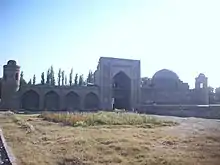
Before the Soviet invasion, education was limited in Dushanbe, mainly consisting of madrasas that taught the Quran and Persian and Arabic along with geography, geometry, algebra, and other sciences. After the invasion, the Soviet Union closed the madrassas down.[106] Today, 60% of university students are enrolled in Dushanbe, which has 23 universities with 103,600 students, 13 colleges with 16,100 students enrolled and 140 schools that have 180,800 students.[35]
Soviet times
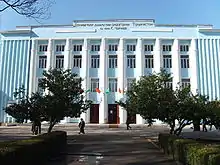
The Soviet education system was considered a success for its time, achieving close to 100% literacy through a large scale literacy program and compulsory education along with the inclusion of girls in education.[107][106] The People's Commissariat of Education of the Tajik SSR was created on 11 February 1925 in Dushanbe.[108]
Higher education began to be established in the 1930s with the creation of a pedagogical institute in Dushanbe in 1931. In 1939, the Tajik State Medical University was founded in Dushanbe and soon after in 1944 the Tajik Agrarian Institute moved to Dushanbe. While World War 2 slowed the growth of higher education, afterwards in 1947 the Tajik State University was created. In 1956 a polytechnic institute was created in the city along with the Institute of Physical Culture in 1971, the Institute of Arts in 1973, and the Tajik Pedagogical Institute of Russian Language and Literature in 1980 which became the Tajik State Institute of Languages in 1987. In 1990, the Technological University of Tajikistan was founded.[106]
The Soviet system was based on the needs of the economy; the agrarian, medical, and polytechnic institutes were all founded to aid the economy. Outside of that, most higher education in the system were in the form of pedagogical colleges. Restrictions on political subjects such as history hampered advancements in those fields.[106]
Independence
.jpg.webp)
The civil war after independence devastated the education system of the city, with state budgets falling from 11% to 2% during the time period. While state spending declined, private institutions temporarily developed in the market economy, accounting for growth in the number of universities in Dushanbe after independence. The modern state university in Dushanbe, the Tajik State Pedagogical University, has an enrollment in the thousands. Institutions such as the Tajik Technical University, the Tajik Agrarian University, the Tajik State University of Commerce and the Technological University of Tajikistan, some of which existed during the Soviet era, grew and admitted anywhere from 5000 to 9000 students.[109] Specialized and technical schools also expanded significantly.[107]
As of 2015, there is one national university in Dushanbe, the Tajik National University, 7 specialized universities, 4 international bilateral institutions, and 12 institutes in the capital. The Russian-language Russian-Tajik Slavonic University was created in the 1990s during a trend of closure of Russian language instruction due to the exodus of Russians during the civil war. The Islamic Institute of Tajikistan, created with the goal of countering Islamic extremism, had 924 students as of 2020.[110][111] The University of International Relations, which was founded by a Tajik-American, was founded in opposition to the government and produced opposition leaders until it was shut down. In 2009, due to the efforts of Emomali Rahom, a Dushanbe branch of the Moscow State University was opened. 70% of the instructors are Russian, while only 30% are Tajik. Other Russian branches in Dushanbe include a branch of the Moscow Institute of Steel and Alloy and a branch of the Moscow Energy Institute.[109]
The Tax Law Institute in Dushanbe had 13000 students in 2003-2004 but was reorganized into the Tajik State University of Finance and Economics. After independence, universities less precisely tailored their courses to the economy and as a result economists and lawyers proliferated in schools such as the Tajik University of Law, Business and Politics.[112]
The Tajik National University is the most prominent in the city and the country. With an enrollment of over 21,000 students and a large number of programs it is the flagship university of Tajikistan. Uniquely, the university is directly funded by the government while also being more independent of it compared to other state universities. While in principle this provides academic freedom, in reality the government is still heavily involved, censors content, and controls appointments at the university.[113]
Dushanbe's education system is still heavily managed by the national government, a relic of Soviet times.[113]
Other schools include the Tajikistan Humanitarian International University and the Dushanbe International School and there are 105 preschools in Dushanbe as of 2004.[107]
Transportation
Air transport
The first flight to the city was from Bukhara on 3 September 1924 of the Junkers F-13 aircraft piloted by Rashid Beck Ahriev and Peter Komarov; the service began to run three times a week from small airfield on modern day Rudaki Avenue.[114] In 1927, the second air route in the Soviet Union was opened from Tashkent to Samarkand to Termez to Dushanbe on the Junkers F-13, two years before the introduction of automobiles and five before the railway. A small Stalinabad airport was created, and in 1930 a first-class airport was constructed in the city. The first scheduled flight from the city to Moscow began in 1945 on the Li-2.[51] The state airline, Tojikiston, which is now known as Tajik Air, was created in 1949. In the 50s and 60s, many new aircraft were introduced to the Tajik Civil Air Fleet. The Tajik Civil Aviation Administration won first place in the USSR for efficiency in the 1980s.[115]
The city is served by Dushanbe International Airport which, as of April 2015, had regularly scheduled flights to major cities in Russia, Central Asia, Delhi, Dubai, Frankfurt, Istanbul, Kabul, and Ürümqi amongst others. Tajik Air had its head office on the grounds of Dushanbe Airport in Dushanbe.[116] Somon Air, which opened in 2008, has its head office in Dushanbe.[117] The government planned to devote .18% of Tajikstan's GDP to the development of aviation in a large part in Dushanbe.[115] Japanese investors created a cargo terminal at the airport, costing $28 million.[118]
Rail transport
The first rail line in Dushanbe, which was 245 kilometers long, was built from 1926 to 1929 and opened on 10 September 1929 from Vhadat to Dushanbe to Termez[119][120] that ultimately connected Dushanbe with Moscow. In 1933 and 1941 two other narrow-gauge railroad lines were laid from Dushanbe, to Gulpista and Kurgan-Tyube. In 2002 a new railroad administration took over that modernized the system.[121]
Today, Tajikistan's principal railways are in the southern region and connect Dushanbe with the industrial areas of the Gissar and Vakhsh valleys and with Uzbekistan, Turkmenistan, Kazakhstan and Russia.[122] Tajikistan's railways are owned and operated by Tajik Railway. In the early 2000s a new railway line from Dushanbe to Gharm to Jirghatol was construed that would connect the country to Russia, Kazakhstan, and Kyrgyzstan while not going through Uzbekistan. A proposed line from Dushanbe to Herat and Mashad is also being promoted by the government.[120] On 18 June 2018 the first railway between Dushanbe and Nur-Sultan, the capital of Kazakhstan, completed its trip through Uzbekistan's Karakalpakstan region.[123] Tajikstan's northern railway system remain isolated from its other railway lines, including those of Dushanbe. There is also a service from Dushanbe to Khujand and the northern Uzbek town of Pakhtaabad.[120]
Trolleybus system
.jpg.webp)
The Dushanbe trolleybus system began on 6 April 1955 when a trolleybus administration was organized in the city. On 1 May 1955 the first Trolza trolleybus began operation on Lenin Avenue, the main avenue of Dushanbe. Routes continued to be added in 1957 and 1958 and in 1967 9 routes were opened and the length of the network reached 49 kilometers. The collapse of the Soviet Union led to a crisis in the system, as fuel increased in price and looting became a consistent problem, with one incident occurring at the central bus station leading to the temporary suspension of lines. During the period, the number of trolleybuses declined from a high of 250 during the late 1980s to only 45–50. 100 new trolleybuses were ordered in 2004 which were delivered a couple years after and aided in the resumption of service.[124]
In 2020, the European Bank for Reconstruction and Development gave $8 million to repair the system. As of 2020, Dushanbe had 7 trolleybus routes with 11 million passengers a years.[125][126] While trolleybuses were the main mode of transport in the Soviet era, today they account for only 2% of motorized trips.[127]
Fleet
Dushanbe trolleybuses are based upon the ZiU-9 trolleybus design.
Metro system
The construction of an above-ground metro system is due to begin in 2025.[125] The first aerial metro line is expected to be completed in 2040 and connect the Southern Gate and Gulliston (circus area).[129]
Road system
The first road in the country, from the early 19th century, was to Guzor, traversed by camels, and made into a modern road by the Soviets. The first bus line was started in 1930 and taxi service began in 1937.[114] Automobiles are the main form of transportation in the country and in Dushanbe. One major road goes through the mountains from Khujand to Dushanbe through the Anzob Tunnel, constructed by an Iranian operator.[130] A second major roads goes east from Dushanbe to Khorog in the Gorno-Badakhshan Autonomous Province and then goes to Murghab and then onto China or Kyrgyzstan.[131]
Many highway and tunnel construction projects are underway or have recently been completed (as of 2014). Major projects include rehabilitation of the Dushanbe – Chanak (Uzbek border), Dushanbe – Kulma (Chinese border), Kurgan-Tube – Nizhny Pyanj (Afghan border) highways and construction of tunnels under the mountain passes of Anzob, Shakhristan, Shar-Shar[132] and Chormazak.[133]
Infrastructure
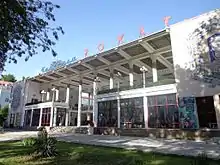
Architecture
Before the Soviet invasion, Dushanbe consisted of narrow streets with adobe buildings.[134] Dushanbe's architecture went through five periods of development during the Soviet period. The first was during the 1920s, which laid the groundwork for future development. In the 1930s, constructivist architecture began to gain prominence along with the building of larger structures, often made out of concrete.[91][135] Several architects played a major role in the city's construction in a group headed by Peter Vaulin. He drew up a piece of legislation called "On the construction of the city of Dushanbe" which the city adopted on 27 April 1927. He implemented a constructivist design in the city, possibly inspired by his meeting with Le Corbusier in Moscow in 1929.[136]
In 1934 and 1935, the Griprogor Institute, based in Leningrad, created a master plan for the construction of Dushanbe. It was approved on 3 March 1938. The city center during the reconstruction shifted to Red Square and Frunze Park, the location of many workers demonstrations and military parades into the forties. In the later half of the decade much of the modern infrastructure and utilities for the city were created. In the 1940s architecture was focused more on decoration and the neoclassical style.[135][91]
1955 heralded in a new era of architecture with the publication of "On the elimination of excesses in the design," which eventually ended the neoclassical period and integrated the city architecture into modernist, minimalistic Soviet trends.[135] In 1966 a new master plan for the city was created due to the city's rapid growth.[91]
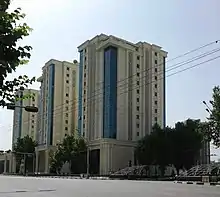
The first skyscraper in Dushanbe, the hotel Dushanbe, was erected in 1964.[51] High-rise buildings began to be developed in the mid-70s against the wishes of the Tajik Institute of Earthquake Engineering and Seismology, which viewed such developments as dangerous in an earthquake which they predicted would occur in the near future.[37]
In the 1980s, more technically complex and creative designs were built by a new generation of architects along with more attention on ecological issues.[135] In the late 1990s, more 9-12 story concrete houses were built and private companies began to make up 75% of the housing market.[134] Minimalist influences continued to be felt from the 60s up to the 90s.[91]
In the 21st century, new construction projects such as tall skyscrapers, a new parliament building, and the national museum were or are being built. However, the new architectural styles of the modern day resulted in the demolition of many historical, Soviet era buildings with the exception of a small list of 15 historically significant buildings.[137]
Electricity
_-_panoramio.jpg.webp)
In the 1930s hydroelectricity began to take off in Dushanbe, leading it to be one of the most advanced in terms of energy production in the Soviet Union at the time; today, 96% of the country's power comes from hydroelectricity.[138][139] In 2007, there was a major energy crisis because of the cold winter in Dushanbe that rendered Dushanbe's Soviet-era energy system ineffective and caused a severe crisis due to lack of heating.[140] In 2012, natural gas imports from Uzbekistan were cut off, which further exacerbated the crisis, although they were restored in 2018.[141] The Nurek hydroelectric dam, as of 2016, provides around 3/4 of the country's power.[142] New hydroelectric plants are being planned[143] and in 2017 the government proclaimed an end to the rolling blackouts;[139] however, in 2020, rolling blackouts continued.[144] Barqi Tojik is the major energy producer for the city and produces 75% of the electricity in the country.[145] To alleviate the energy crisis, a second coal plant for the city is planned with extensive Chinese involvement, but has been criticized for pollution and negative environmental effects.[138]
Varzob's three power plants generated 150 million kWh per year in 2004, and Dushanbe's power supply, built on the idea of a double ring, has an outer ring of power transmission lines from Nurek Dam to Dushanbe to Yovon at a voltage of 220 kW and an inner ring which covers the perimeter of the city and consists of 110 kW power lines. In Dushanbe, 990 million kWh were generated in 1980 and reached 1161 million kWh in 1985 which decreased significantly in 2001.[146]
Water and sanitation
Tajikistan has the highest average annual precipitation in its region, along with numerous rivers, natural lakes (such as Lake Karakul), and glaciers. Most of the water system in Dushanbe was built during the Soviet era and not significantly expanded afterwards even with a rising population.[147] The Big Gissar Canal was constructed in 1942 and irrigates much of southern Tajikistan and goes from the Kofarnihon river to the Surxondaryo.[148] In Dushanbe itself, much of the water system dates from 1932, with the majority of underground water and sewage pipes out of date. As of 2004, the length of the city's water supply network was 476 km and mainly got its water from the Varzob, Kofarnikhon and the South-West.[149] As of 2018, 40% of the city's population did not have access to sewage systems.[150]
Parks
As of 2020, there are 15 parks in Dushanbe.[151] One of the most well known is Rudaki Park, created in the mid 1930s along with a bronze statue of Lenin.[152] The park was renovated in 2007.[153] Another park is Victory Park, which was created in 1975 to commemorate the Great Patriotic War.[154] The Botanical Garden of the Academy of Sciences of Tajikistan was founded in 1933, and trees planted then are still prominent in the park. In 2007 a collection of folk architecture was added the park.[155]
- Parks in Dushanbe
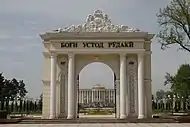 Rudaki Park with the Palace of the Nation in the background.
Rudaki Park with the Palace of the Nation in the background.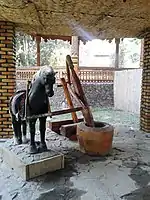 Folk architecture area of the botanical gardens
Folk architecture area of the botanical gardens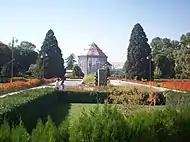 Dushanbe botanical gardens
Dushanbe botanical gardens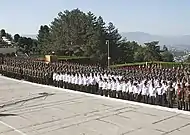 A parade in Victory Park
A parade in Victory Park_-_panoramio.jpg.webp) World War 2 memorial in Victory Park
World War 2 memorial in Victory Park
Cemeteries

There are 5 main and 14 unrecognized cemeteries in Dushanbe.[156]
One of the 5 mains ones is Mekhrobod, founded in 2013, that consists of 74 acres of primarily tombstones. For a period of 9 months in 2019, 78 people were buried there. Luchob cemetery, also one of the five, uses commemorative steles to remember the dead and houses more well-known figures. As of October 2019, 54 people were buried there such as Jabbor Rasulov, Bobojon Ghafurov, Muhammad Osimi, Mirzo Tursunzade, Loik Sherali, Muhammadjon Shakuri, Malika Sabirova, Tufa Fozylova, and Mukaddima Ashrafi. It was founded in 1977 and uses the smallest amount of land of the five.[156] In 2017, the government secretly moved many national figures from Aini park to Luchob cemetery, sparking outrage.[157]
Sari Osiyo, founded in 1933, is another one of the five cemeteries. It is one of the oldest in the city and has graves from the late 19th century. For a 9-month period, 225 were buried here. The Christian cemetery is another one of the five, the least visited although frequented by the 201st Russian division. It uses 84.3 hectares of land and saw 197 news graves over the nine-month period. Shokhmansur is the last of the five main cemeteries and saw 65 burials over the 9-month period.[156]
The Jewish cemetery of the city is looked after by the Congress of Bukharian Jews.[158]
Healthcare
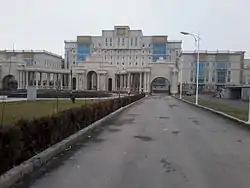
In 1925, Dushanbe city hospital and the ambulance system was created, and numerous medical facilities sprung up during the decade. In 1939, an infectious disease hospital was created and in the same year the Stalinabad Medical Institute was founded. During World War 2 up to the Civil War the healthcare system significantly expanded through hospitals and specialized clinics.[159]

Tajikistan's health care system is concentrated in Dushanbe.[160] Temporary hospitals were established during the COVID-19 pandemic.[161] Some hospitals in Dushanbe include the Mansurov Clinic, the Tajik Railways Hospital, the Shifobakhsh National Medical Center, and the Istiqlol Medical Complex.[162] Khoja Obi Garm, a Soviet-era sanatorium, still is in operation today and uses radon treatments, among others.[163]
In Dushanbe, there is a well-developed network of city clinics, hospitals, medical centers, maternity hospitals, orphanages, sanitary and epidemiological centers - a total of 62 medical institutions in the city as of spring 2010. These 62 treatment and prevention facilities include 17 hospitals, 2 orphanages, 14 city health centers, 5 dental clinics, 8 centers of sanitary and epidemiological surveillance and disincentives, 12 city branch centers and 4 support centers.[164]
Primary health care for Dushanbe residents (and guests of the city) is provided in 39 institutions (city health centers, dental clinics, centers for sanitary and epidemiological surveillance and de-stations, city branch centers).[165]
Among the main medical institutions of Dushanbe are specialized republican hospitals and centers, city polyclinics No. 1-5, the city infectious diseases hospital, the children's infectious diseases hospital, and the departmental hospitals of the country's power ministries.[166]
Economy
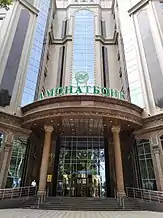
In 2018, the gross regional product of Dushanbe was 13,808,000,000 somoni, equaling approximately $1,400,000,000, with a growth rate of 7.3%. That comprised 20.1% of the overall GDP of Tajikistan.[167] In the first half of 2020, the GRP of Dushanbe was 20.7% of the GDP of the country.[168] Exports from Dushanbe consisted of $8,343,200 during the first half of 2019.[169] The average salary of the city is 1402.67 somoni and there is a high inflation rate of 8.9% as of 2014, and $499.7 million were invested into the city from foreign sources during the same time period.[72] As the center of financial activity of the republic, Dushanbe housed more than 30 commercial banks in 2004.[146]
Industry
.jpg.webp)
During and during the decade after the Soviet invasion, most industries were focused on meeting local demand with local materials. Meat packing, soap production, bricks, lumber, silk thread, leather, clothing, and generation of electric power were all local industries during the time period.[41] In 1932 776 workers were employed in industry, while in 1938 12 thousand were.[146] During World War 2, the city's industry grew significantly with the Soviet decision to relocate industry eastwards to cities like Dushanbe, specifically light industries like textile manufacturing and food processing.[41] Industry output increased by 2.5 times from 1940 to 1945.[20] About 1/3 of the industrial and white-collar labor force of Tajikistan is located in Dushanbe, despite containing less than 10 percent of Tajikistan's population.[41] From January to August 2019, there were 455 manufacturing companies in Dushanbe, producing 1,644,745,400 Somoni worth of products. The majority of that, 63.9%, was from the processing industry, 34.5% was from electricity, water, gas, and air purification, and the other 1.6% was from the non-metallic construction industry.[169] The industry produces over 300 types of products.[170] Exports from the industrial sector consisted of $1,535,500 during the time period.[169]
The main industrial products exported from the city are cotton yarn, finished cotton fabrics, hosiery, cable products, agricultural products, tobacco products, and trade equipment, among others.[170] Industry, as of 2019, employed 20746 people, with an average salary of 1428.02 somoni.[169] Light industry is the most mature industry in the city, aided by the location of raw materials in the country. Some large companies in light industry are Nassoch, which processes large amounts of cotton fiber, Chevar and Guliston, which both produce garments, and Nafisa, which produces hosiery.[170] The electrical, engineering, and metallurgical industries are also prominent in the republic. Tajiktekstilmash, which produces varied products for agriculture and electricity, and Tajikcable, which produces cables, are two well known companies from that sector of the economy. Somon-tachkhizot, which produces electronic goods, Torgmash, which produces good for trading companies, and Valve Plant, which produces iron products are some other prominent companies in the industry.[170] The food processing industry also has a presence in the city with many wineries, dairy and meatpacking plants, canneries, and bakeries all in the city. Building materials, such as cement, oil and plastics, of which there are 3 main gas deposits,[171] wood, and printing, which was 80% of the republic's capacity and began in 1926,[146] are all created or completed in the city as well.[170]
Retail
In 2014, the retail sector was involved in 2.6 billion somoni of transactions. In the service sector, hotels, restaurants, canteens and cafes sold services worth 296.6 million somoni. The paid services of the city in 2014 amounted to 5662.2 somoni per capita.[72]
Tourism

Dushanbe is the capital of tourism of the Economic Cooperation Organization and is served by more than 40 hotels. The building of 9 modern hotels, with room for more than 1000 people, is being planned.[172] In 2018 and 2019 numerous initiatives, such as Dushanbe becoming a member of the World Tourism Cities Federation, different festivals, legislation promoting the city, an art gallery, and the establishment of the Year of Tourism and Folk Crafts in 2018 all served to promote the tourism industry. The Dushanbe Summer Fest, another promoted festival, is notable for its internet connectivity.[173][174][175] Compared with the rest of the country, however, Dushanbe is a less popular tourist destination, partially due to its relatively recent founding and lack of historical significance.[176]
Museums in the city include the Tajikistan National Museum, founded in 1934,[177] and the Gurminj Museum of Musical Instruments which contains Pamiri and Badakshani musical instruments.[178]
Culture
Music
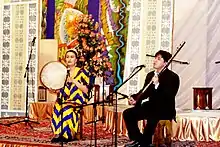
During the 19th century, shashmaqam was the most prevalent music in Tajikistan. While Soviet authorities labeled it as "music composed for the Emir" and repressed it, in modern times it has gained greater popularity.[179]
During the Soviet period, the Soviet Union encouraged the development of music in Dushanbe, a less culturally crowded place then typical Russian megacities. Revolutionary songs, like the Marseillaise, were promoted and translated into Tajik.[180] The Tajik Philharmonic Society was founded in 1938; today, it is named after Akasharif Juraev.[181][182] Sergei Artemevich Balasanyan, an Armenian, was one composer who originally went to Dushanbe from 1936–1943 to prepare the SSR for an upcoming Tajik cultural festival to be held in Moscow. While we was there, he described himself as a "composer, social-musical worker, folklorist, and pedagogue." He also became the head of the Tajik Composer's Union and the artistic lead of the opera house.[179] Large numbers of Russian and Ukrainian symphonies moved to Dushanbe during World War 2.[183]
The Tajik Opera and Ballet Theater, whose building was named after Sadriddin Ayni and was the first opera house in Dushanbe, was founded in 1936.[184][185] The first opera performed, the first in history of Tajikistan, was The Vose Uprising and detailed a peasants' revolt in eastern Bukhara in the late 19th century.[186] One notable singer of the opera was Hanifa Mavlianova.[187]
Another musician to come to Dushanbe during the Soviet period was Aleksandr Lensky, a Moldovan who came to Tajikistan in 1937. He was the artistic director of the Lahuti Theatre, director of the Tajik Phillharmonic, and first secretary of the Tajik Union of Composers. He also composed the first Tajik opera and many orchestral pieces.[179] Another orchestra in Dushanbe is the Opera Orchestra.[188] The State Symphony Orchestra of Tajikistan was founded in 2016, and its first concert took place on 9 September 2016.[189][190] The Tajik Opera and Ballet Theater continues operating to this day and has won the Order of Lenin.[184] At various times the opera house performed operas on modern, historical, national, revolutionary, and heroic themes.[185]
Dance
The Tajik Opera and Ballet Theater also had the first ballet performed in Dushanbe in 1941, entitled Two Roses, and the ballet troupe gradually grew over time.[187][191] The troupe was improved with graduates from the Leningrad Choreographic School with ballet dancers such as Malika Sabirova.[187] The theater was refitted in 2009 and continues operating to this day.[192]
Literature
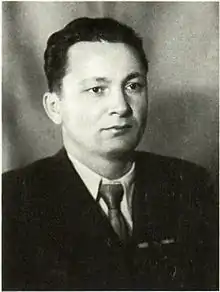
The first printing press in Tajikistan was created in August 1924, the Tajik State Publishing House, the Donish Publishing House was founded in 1944.[193] In 1925 4 books were printed, which grew to 13 in 1926. In 1930, Sadriddin Ayni wrote the first Tajik novel, Dokhunda.[194] Publishing houses established in 1934 and the Academy of Sciences of Tajikistan publishing house dramatically increased book production in the city.[195] The Maorif Publishing House was created in 1975.[193] In 2004, there were 30 publishing companies in the city.[195]
Dushanbe became the center of Tajik literature in the 1920s with figures such as Sadriddin Ayni, Abolqasem Lahouti, and Payrav Sulaymoni along with new Soviet literature calling for revolution and social equality and Tajik nationalist literature. Children's books and translated works also had their beginnings in this period. In the 1930s, young Russian writers influenced the literature of the city, part of the "Komsomol generation." The themes often touched on the rapid development of Dushanbe during the 30s.[196]
During World War 2, literature shifted towards patriotic and militaristic themes of protecting the motherland in shorter formats than novels. Messages from the frontlines and satires became popular. Russian literature also became known, partially due to the movement of factories and people from the frontlines of the war to the east. After the war, prose works and poetry, with poets like Mirzo Tursunzoda, became more popular along with the continuation of genres from previous decades. Literary criticism developed along with analysis of individual writers.[196]
From the 1950s, the historical revolutionary genre developed, prompting authors to use history for inspiration. In the 60s the new genre of science fiction began in the city with writers like Mirsaid Mirshakar. In the 70s and 80s the themes of disorder gained more prominence, not coincidently soon before the Soviet Union's collapse. In poetry, civic and philosophical lyrical themes were most popular.[196] After independence, previously forbidden subjects like religion started to appear in literature, along with reflections on the civil war and a more international scene has developed in the city.[196]
Theater
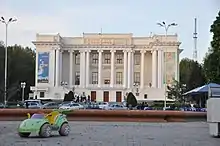
The 1920s saw the birth of drama in the city. The first, Lahouti theater, was built in 1929. In the 1930s, Soviet themes like class struggle, fighting against the past, and gender equality were prominent in plays. In 1935, the Tajik Musical Theater, now the Ayni theater, was built.[183][196] A comedy troupe was created in 1944 and after the war young artists influenced plays in Dushanbe, influencing the creation of the Tajik State Youth Theater.[183]
Continuing with a nationalist tradition, Tajik classics were made into plays. During World War 2, plays were focused on the war and historical themes from the 1950s onward. In the 70s and 80s foreign plays, like Oedipus Rex, were introduced to Dushanbe. After independence, plays focused primarily on the devastating civil war.[196][183] Today, some theaters are the Tajik Academic Opera and Ballet Theater, the State Russian Drama Theater, the youth theater, the State Experimental Theater, and the republican puppet theater.[183]
Sculpture
Sculpture was first introduced to Dushanbe in the 1920s and throughout the Soviet period was focused on combining modern culture and a classical heritage. Modern sculpture mainly has historical subjects like Firdavsi, Shah Anushirvan, or Ismail Samani.[97]
- Statues in Dushanbe
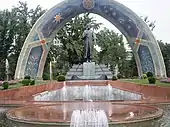 Statue of Rudaki
Statue of Rudaki.jpg.webp) Statue of Omar Khayyam
Statue of Omar Khayyam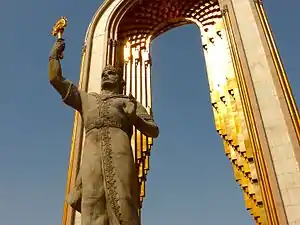 Statue of Ismail Samani
Statue of Ismail Samani Statue of Lenin
Statue of Lenin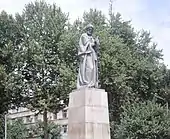 Statue of Avicenna
Statue of Avicenna
Painting
Painting in Dushanbe got its start when Russian painters moved to this city in the 20s and 30s. By the 50s, Tajik artists started to paint. In the 1960s, the severe style [ru] grew and in the 70s and 80s a focus on Tajik heritage and nationalism was predominant. In the late 80s, however, painting shifted from a focus on historical figures to emotional depth and personality. During the civil war, a theme of conflict in painting developed.[97] Sabzali Sharipov's black and white series was devoted to the civil war.[197]
Film
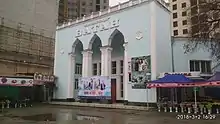
Cinema in Dushanbe started in the 1930s with the creation of film studios and cinemas by the Soviet government, although the first cinema was created in 1927 where residents watched Nibelung by Frits Lang. Komil Yarmatov was the first prominent Tajik film director. Documentaries were also popular in this period. In World War 2, feature film production in Dushanbe was suspended due to lack of supplies. After the war, more feature films were developed, with many movies attempting to create a portrait of the city. In the 1980s a new generation of filmmakers brought new values such a pluralism into the theater, which led to some films focusing on the truth of Soviet history. During the civil war, the landscape changed dramatically. Tajikfilm, which formerly had a monopoly on filmmaking, had to shut down, while independent filmmakers chronicled the horrors of the civil war.[180]
Sports
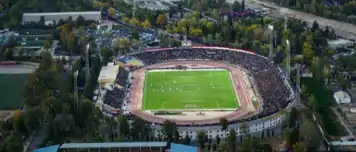
Gymnastics, equestrian sports and athletics were practiced in 1923 at the Dushanbe sports club and in 1929 tennis was introduced. The All-Tajik Spartakiad was first held in 1934, and in 1939 Dynamo Dushanbe won the quarterfinals of the Cup of the USSR. In 1950 the country's soccer team took first place in the Central Asian Games. As of 2004, there were 10 sports schools in Dushanbe. In 2003, Dushanbe hosted the Central Asian Games. The most popular sports in Dushanbe are sambo, wrestling, judo, karate, taekwondo, artistic gymnastics, weightlifting, archery, shooting, boxing, football, basketball, diving, tennis, chess, Buzkashi, and checkers.[198]
The Pamir Stadium in Dushanbe was constructed in 1939 where CSKA Pamir Dushanbe played.[199] As of 2020, 4 soccer teams of the Tajikistan Higher League play in Dushanbe: CSKA Pamir,[200] Dushanbe-83,[201] Istiklol,[202] and Lokomotiv-Pamir.[203]
_%D0%B2_%D0%94%D1%83%D1%88%D0%B0%D0%BD%D0%B1%D0%B5_(1).jpg.webp)
Holidays
Some official holidays in Dushanbe include New Years, Nowruz, Victory Day, Shashmaqom Day, Independence Day, and Eid al-Fitr.[204][205]
Media
Newspapers and magazines
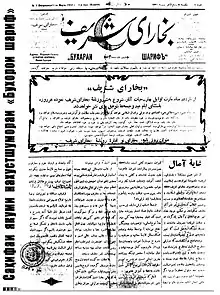
The first newspaper published in Tajik was Bukhara Sharif in Kagan on 11 March 1912 and published by leaders of the Jadid movement like Mirzo Jalol Yusufzoda. The purpose of the newspaper was to "be a scientific, literary, directional, subject, and economic publication that will strive for the spread of civilization and the idea." Soon after, however, Ivan Petrov requested that the Emir of Bukhara close the paper, which he did on 2 January 1913.[193]
Oina and Mullo Nasreddin were two of the earliest Tajik language magazines. The Zvezda Vostok magazine was published in Tajik in the early 1920s in support of the October Revolution. The first Soviet newspaper distributed in Tajikistan was Shulai Inkilob (Flame of the Revolution) as propaganda for the Soviet government in 1919. It was distributed throughout Tajikistan and was the main Tajik language newspaper that opposed the previous Emirate and was clearly in support of communism, the October Revolution, and the Bukharan Communist Party.[193]
The first Soviet newspaper published in Tajikistan was Po basmachi which detailed the conditions of the Red Army in Tajikistan in 1923 during the Basmachi movement. In 1924, the newspaper Voice of the East, the first Soviet government newspaper in Tajik was published in Dushanbe and was a forum for much of the poetry and literature of the young republic. In 1925, the official newspaper of Soviet Tajikistan was "Bedorii tochik" (Awakening of the Tajiks). An Uzbek-language paper, Red Tajikistan, was published in Tajikistan as well. Sadriddin Ayni also published many newspapers such as Bukhara News, Horpustak, and Flame of the Revolution.[193]
In 1929, the newspaper Red Tajikistan came into print with a large daily circulation of 5000. In the 1930s Komsomolets Tadzhikistana was published as a communist paper intended for the youth of Tajikistan. Many other newspapers were published during this time as well. The press often emphasized the collective farming system and the newspaper Dehkoni Kambagal was popular among farmers.[193]
During World War 2 newspaper production was strained as raw materials became increasingly scarce and their numbers were reduced. After the war, the many newspapers from the 30s began to be produced once again. In the 60s and 70s the newspaper Communist of Tajikistan gained prominence, winning the Order of the Red Banner of Labor. International cooperation also began to be emphasized during the time period.[193]
During perestroika, newspapers began to embrace more liberal and democratic ideas. One of the first to do this was the Komsomol of Tajikistan. Farkhang, a new literary magazine, published national Tajik and Islamic literature banned before such as the Masnavi. The Sukhan newspaper, published by the Union of Journalists of Tajikistan, was a leading voice for liberalism and perestroika in the republic, writing about topics such as freedom of speech, democratization, and the opposition. The first publication not released by the state was from Rastokhez, printed in Lithuania and delivered to Dushanbe. The Democratic Party of Tajikistan published a paper, Justice, in Dushanbe as well which had a circulation of 25000. Charogi Ruz, or Light of Day, was the first private publication in Dushanbe, and advertised itself as the free tribune for youth. Free publications such as Oinai zindagi (by trade unions), Somon, Haftgandzh, and others began to form.[193] Today, Charogi Ruz is known for its sharp criticism of the ruling government.[206]
In August 1999 there were officially 199 newspapers, although only 17 of those appeared regularly. Some of the most widely circulated national government publications are Dzhumhuriet and Narodna Gazeta. In addition to the state news agency Khovar (News), there are several private newspapers, including Asia-Plus, which regularly publishes in Russian and English and reports on political, social and economic issues.[207]
Radio
In 1924 a radio station was built in Dushanbe for military communication. On 10 April 1930 the first radio broadcast was heard by civilians in Tajikistan, from Moscow. It functioned as a news source and a source of Soviet propaganda. The first station, in Dushanbe, mainly focused on retransmitted broadcasts from Moscow and radios gradually became more prevalent in the country. While development slowed during World War 2, afterwards Tajikistan received higher broadband and quality radio stations and broadcasts.[193]
In 1977, locally created radio broadcasts were able to be transmitted from Dushanbe thanks to the construction of the Radio House in the city. In 2000, the Sadoi Dushanbe Radio was created, and today that is one of the four programs broadcast in Dushanbe.[193]
As of August 1999 government radio is broadcast throughout the nation along with independent outlets such as Asia Plus radio.[195] Radio Liberty, the BBC, and Sadoi Khuroson are also broadcast in Tajik, although no independent radios were operating.[207]
Television
On 7 November 1959 the first television center was created in the republic, the Tajik Television Studio. In 1967 programs from Moscow and Tashkent were broadcast in the country and on 15 November 1975 color television was introduced.[193]
As of August 1999 12 to 15 stations broadcast consistently. Many Russian language channels like ORT, RTR, and TV-6 broadcast as well.[207] Today, a greater number of private television stations operate in the city.[195]
International relations
Twin towns – sister cities
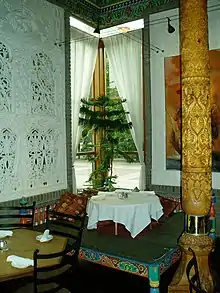
Dushanbe is twinned with:[208]
 Ankara, Turkey
Ankara, Turkey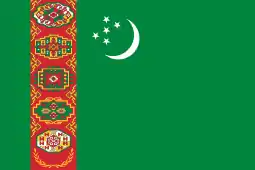 Ashgabat, Turkmenistan
Ashgabat, Turkmenistan Boulder, United States
Boulder, United States Hainan, China
Hainan, China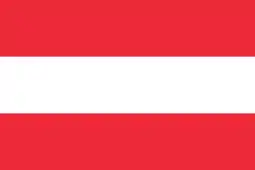 Klagenfurt, Austria
Klagenfurt, Austria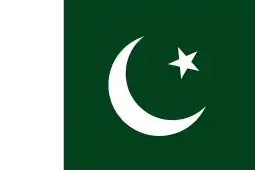 Lahore, Pakistan
Lahore, Pakistan Lusaka, Zambia
Lusaka, Zambia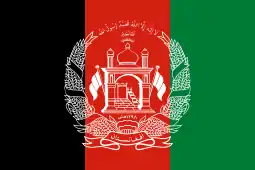 Mazar-i-Sharif, Afghanistan
Mazar-i-Sharif, Afghanistan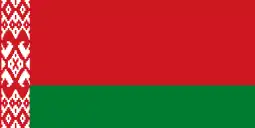 Minsk, Belarus
Minsk, Belarus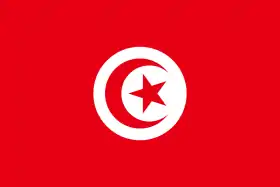 Monastir, Tunisia
Monastir, Tunisia Qingdao, China
Qingdao, China Reutlingen, Germany
Reutlingen, Germany Saint Petersburg, Russia
Saint Petersburg, Russia Sanaa, Yemen
Sanaa, Yemen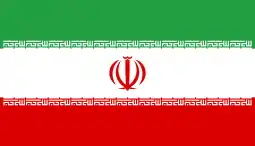 Shiraz, Iran
Shiraz, Iran Tehran, Iran
Tehran, Iran Ürümqi, China
Ürümqi, China Xiamen, China
Xiamen, China
Boulder, Colorado
In 1982, Mary Hey and Sophia Stoller started an initiative to make Dushanbe a sister city of Boulder even though during that time they were on opposite sides of the Cold War. In 1987, the mayor of Dushanbe, Maksud Ikramov, officially made Boulder a sister city of Dushanbe. Exchange students, tourism, and art exchanges began between the two cities. The Tajik Teahouse was sent from Dushanbe to Boulder in 1990. During the civil war, Boulder sent humanitarian aid to Dushanbe.[209]
International conferences

Many international conferences have been held in Dushanbe, such as the International Conference on Integrated TB Control in Central Asia[210] and the hosting of the Shanghai Cooperation Organization conference in 2000 and 2008.[211][212]
In 2003, Dushanbe hosted the International Forum on Fresh Water which was attended by 50 states and organization.[213][214]
From 20 to 23 June 2018 the High-Level International Conference on the International Decade for Action 'Water for Sustainable Development' was held in Dushanbe, which discussed the upcoming decade for action with regards to water.[215] A second conference on the same subject was planned to be held in June 2020.[216]
On 16–17 May 2019 a high-level conference entitled "Countering Terrorism and its Financing Through Illicit Drug Trafficking and Organized Crime" was held in Dushanbe and attended by more than 50 countries. It passed the Dushanbe declaration, which put the primary responsibility for fighting terrorism onto national governments. Other topics, such as drug smuggling, were also discussed.[217]
On 15 June 2019 the fifth summit of the Conference on Interaction and Confidence-Building Measures in Asia was held in Dushanbe. The Asian members of the organization discussed common interests on topics such as peace and security, terrorism, arms control, the Iran nuclear deal, poverty, economic development, and globalization.[218]
Notable people
- Farrukh Amonatov (born 1978), chess grandmaster
- Daniel Bar-Tal (born 1946), Israeli academic
- Gulsara Dadabayeva (born 1976), long-distance runner
- Zuhur Habibullaev (born 1932), artist
- Malika Kalontarova (born 1950), dancer
- Jamshed Karimov (born 1940), Tajik prime minister
- Vladimir Landsman (born 1941), violinist
- Alexander Mironenko (born 1959), Hero of the Soviet Union
- Zarrina Mirshakar (born 1947), composer
- Shoista Mullojonova (born 1925), singer
- Dilshod Nazarov (born 1982), hammer thrower
- Tahmina Niyazova (born 1989), singer
- Vladimir Popovkin (born 1957), commander of Russian Space Forces
- Umarali Quvvatov (born 1968), opposition figure
- Gulrukhsor Safieva (born 1947), Iranologist
- Tolib Shakhidi (born 1946), composer
- Malika Sobirova (born 1942), ballet dancer
- Vladimir Voinovich (born 1932), Soviet dissident and writer
- Zafar Usmanov (born 1937), mathematician
- Noziya Karamotulla (born 1988), Singer
References
- Вечёрка (27 July 2020). "География Душанбе в цифрах". Вечёрка (in Russian). Retrieved 18 September 2020.
- "About Dushanbe". U.S. Embassy in Tajikistan. Retrieved 1 August 2020.
- https://www.stat.tj/en/publications
- "Sub-national HDI - Area Database - Global Data Lab". hdi.globaldatalab.org. Retrieved 13 September 2018.
- "General information about Dushanbe | Conference on Interaction and Confidence Building Measures in Asia". Conference on Interaction and Confidence-Building Measures in Asia. 30 July 2020. Retrieved 16 January 2021.
The village Dushanbe arose at the crossroads. On Mondays big Bazaar’s would be organized, which is where the village inherited its name "Dushanbe", meaning "Monday".
- Saĭmiddinov, Dodikhudo; Kholmatova, S. D .; Karimov, S.; Kapranov, V. A . (2006). Farḣangi tojikī ba rusī : 70 000 kalima va ibora [Tajik-Russian dictionary: 70,000 words and phrases]. Dushanbe: Academy of Sciences of the Republic of Tajikistan, Rudaki Institute of Language and Literature, Scientific Center for Persian-Tajik Culture. OCLC 76271036.
- "Tajikistan". The World Factbook. CIA. Retrieved 30 January 2020.
etymology: today's city was originally at the crossroads where a large bazaar occurred on Mondays, hence the name Dushanbe, which in Persian means Monday, i.e., the second day (du) after Saturday (shambe)
- "Душанбе / определение слова Душанбе - столица Таджикистана. Город образован в 1925 г. из кишлака Дюшамб".
- "دوشنبه | پارسی ویکی". web.archive.org. 31 January 2016. Retrieved 16 January 2021.
- Ranov, V. A. (Vadim Aleksandrovich) (1993). Dushanbe : gorod drevniĭ (PDF). Solovʹev, V. S. (Viktor Stepanovich), Masov, R. M. (Rakhim Masovich). Dushanbe: Izd-vo "Donish". p. 15. ISBN 5-8366-0427-4. OCLC 32311792.
- "Hissar Culture". TheFreeDictionary.com. Retrieved 2 August 2020.
- Ranov, V. A. (Vadim Aleksandrovich) (1993). Dushanbe : gorod drevniĭ (PDF). Solovʹev, V. S. (Viktor Stepanovich), Masov, R. M. (Rakhim Masovich). Dushanbe: Izd-vo "Donish". pp. 21, 25. ISBN 5-8366-0427-4. OCLC 32311792.
- Ranov, V. A. (Vadim Aleksandrovich) (1993). Dushanbe : gorod drevniĭ (PDF). Solovʹev, V. S. (Viktor Stepanovich), Masov, R. M. (Rakhim Masovich). Dushanbe: Izd-vo "Donish". p. 100. ISBN 5-8366-0427-4. OCLC 32311792.
- Ranov, V. A. (Vadim Aleksandrovich) (1993). Dushanbe : gorod drevniĭ (PDF). Solovʹev, V. S. (Viktor Stepanovich), Masov, R. M. (Rakhim Masovich). Dushanbe: Izd-vo "Donish". pp. 107–108. ISBN 5-8366-0427-4. OCLC 32311792.
- Ranov, V. A. (Vadim Aleksandrovich) (1993). Dushanbe : gorod drevniĭ (PDF). Solovʹev, V. S. (Viktor Stepanovich), Masov, R. M. (Rakhim Masovich). Dushanbe: Izd-vo "Donish". p. 27. ISBN 5-8366-0427-4. OCLC 32311792.
- Yavan, Oxford Art Online. Macy, Laura Williams. [Basingstoke, England]: Macmillan. 2002. ISBN 1-884446-05-1. OCLC 50959350.CS1 maint: others (link)
- "Regions: Dushanbe & Surroundings". Official Website of the Tourism Authority of Tajikistan. Committee of Youth Affairs, Sports and Tourism. Retrieved 10 May 2013.
- Ranov, V. A. (Vadim Aleksandrovich) (1993). Dushanbe : gorod drevniĭ (PDF). Solovʹev, V. S. (Viktor Stepanovich), Masov, R. M. (Rakhim Masovich). Dushanbe: Izd-vo "Donish". p. 110. ISBN 5-8366-0427-4. OCLC 32311792.
- "Southern Tajikistan in Kushana period". National Museum of Antiquities of Tajikistan. Retrieved 2 August 2020.
- "Historical Sketch". Dushanbe : ėnt︠s︡iklopedii︠a︡. Dinorshoev, Muso. Dushanbe: Glavnai︠a︡ nauchnai︠a︡ redakt︠s︡ii︠a︡ Tadzhikskoĭ nat︠s︡ionalʹnoĭ ėnt︠s︡iklopedii. 2004. ISBN 5-89870-071-4. OCLC 65068362. Archived from the original on 28 October 2004.CS1 maint: others (link)
- Ranov, V. A. (Vadim Aleksandrovich) (1993). Dushanbe : gorod drevniĭ (PDF). Solovʹev, V. S. (Viktor Stepanovich), Masov, R. M. (Rakhim Masovich). Dushanbe: Izd-vo "Donish". pp. 125–126. ISBN 5-8366-0427-4. OCLC 32311792.
- Hiebert, F. T.; Kohl, P. L. (20 October 2012). "Garav kala: a Pleiades place resource". Pleiades: a gazetteer of past places. R. Talbert, T. Elliott, S. Gillies. Retrieved 2 August 2020.
- Ranov, V. A. (Vadim Aleksandrovich) (1993). Dushanbe : gorod drevniĭ (PDF). Solovʹev, V. S. (Viktor Stepanovich), Masov, R. M. (Rakhim Masovich). Dushanbe: Izd-vo "Donish". pp. 38–39. ISBN 5-8366-0427-4. OCLC 32311792.
- Litvinskiĭ, B. A. "Ajina Tepe". Encyclopaedia Iranica. Retrieved 2 August 2020.
- Ranov, V. A. (Vadim Aleksandrovich) (1993). Dushanbe : gorod drevniĭ (PDF). Solovʹev, V. S. (Viktor Stepanovich), Masov, R. M. (Rakhim Masovich). Dushanbe: Izd-vo "Donish". pp. 54–55, 85, 90. ISBN 5-8366-0427-4. OCLC 32311792.
- "Illustrations" (PDF). p. 3.
- Ranov, V. A. (Vadim Aleksandrovich) (1993). Dushanbe : gorod drevniĭ (PDF). Solovʹev, V. S. (Viktor Stepanovich), Masov, R. M. (Rakhim Masovich). Dushanbe: Izd-vo "Donish". p. 133. ISBN 5-8366-0427-4. OCLC 32311792.
- Ranov, V. A. (Vadim Aleksandrovich) (1993). Dushanbe : gorod drevniĭ (PDF). Solovʹev, V. S. (Viktor Stepanovich), Masov, R. M. (Rakhim Masovich). Dushanbe: Izd-vo "Donish". p. 136. ISBN 5-8366-0427-4. OCLC 32311792.
- Ranov, V. A. (Vadim Aleksandrovich) (1993). Dushanbe : gorod drevniĭ (PDF). Solovʹev, V. S. (Viktor Stepanovich), Masov, R. M. (Rakhim Masovich). Dushanbe: Izd-vo "Donish". p. 170. ISBN 5-8366-0427-4. OCLC 32311792.
- Turekulova, Natalia; Turekulov, Timur (2004/2005). "Tajikistan: A view from outside". Heritage at Risk. ICOMOS. ISSN 2365-5615. Check date values in:
|year=(help) - Ranov, V. A. (Vadim Aleksandrovich) (1993). Dushanbe : gorod drevniĭ (PDF). Solovʹev, V. S. (Viktor Stepanovich), Masov, R. M. (Rakhim Masovich). Dushanbe: Izd-vo "Donish". pp. 61, 144. ISBN 5-8366-0427-4. OCLC 32311792.
- Ranov, V. A. (Vadim Aleksandrovich) (1993). Dushanbe : gorod drevniĭ (PDF). Solovʹev, V. S. (Viktor Stepanovich), Masov, R. M. (Rakhim Masovich). Dushanbe: Izd-vo "Donish". p. 163. ISBN 5-8366-0427-4. OCLC 32311792.
- Ranov, V. A. (Vadim Aleksandrovich) (1993). Dushanbe : gorod drevniĭ (PDF). Solovʹev, V. S. (Viktor Stepanovich), Masov, R. M. (Rakhim Masovich). Dushanbe: Izd-vo "Donish". pp. 149–151. ISBN 5-8366-0427-4. OCLC 32311792.
- "АҶАБ ШАҲРИ ДИЛОРОЙӢ" [The Wonderful City of Dushanbe]. Садои мардум (in Tajik). 19 April 2013. Retrieved 3 August 2020.
- Abdullaev, Kamoludin (2018). "Dushanbe". Historical Dictionary of Tajikistan. Rowman & Littlefield Publishers. pp. 130–131. ISBN 978-1-5381-0252-7. OCLC 1049912411.
- "Душанбе (столица Таджикистана)". Планета Земля (in Russian). Retrieved 18 September 2020.
- Rusu, Stefan; Dubovitskiy, Victor (2016). Spaces on the Run. Turkey. Istanbul: Dushanbe Art Ground. p. 31. ISBN 978-99947-892-7-6.
- "Аҷаб шаҳри дилороӣ, Душанбе…". tiroz.org (in Russian). 19 July 2019. Retrieved 31 July 2020.
- "Urban Planning and Architecture". Dushanbe : ėnt︠s︡iklopedii︠a︡. Dinorshoev, Muso. Dushanbe: Glavnai︠a︡ nauchnai︠a︡ redakt︠s︡ii︠a︡ Tadzhikskoĭ nat︠s︡ionalʹnoĭ ėnt︠s︡iklopedii. 2004. ISBN 5-89870-071-4. OCLC 65068362. Archived from the original on 28 October 2010.CS1 maint: others (link)
- "Краткая историческая справка". 1 December 2008. Archived from the original on 1 December 2008. Retrieved 2 August 2020.
- Atkin, Muriel. "Dushanbe". Encyclopaedia Iranica. Encyclopedia Iranica Foundation, Inc. Retrieved 1 August 2020.
- ""Русский дом", "Заразка" и "Детский садик" - истории инфекционных больниц Душанбе | Новости Таджикистана ASIA-Plus". asiaplustj.info. Retrieved 2 August 2020.
- Вечёрка (9 July 2019). "Душанбе - столица края". Вечёрка (in Russian). Retrieved 1 August 2020.
- "A Tomb in Kabul: The Fate of the Last Amir of Bukhara and his country's relations with Afghanistan". Afghanistan Analysts Network - English. 27 December 2018. Retrieved 31 July 2020.
- Bleuer, Christian (2013). Tajkistan: A Political and Social History. ANU Press. p. 56. ISBN 978-1-925021-15-8. OCLC 1076650077.
- Projorov, A. M. (1973–1982). "Dushanbe". Great Soviet Encyclopedia. Macmillan. OCLC 435381348.
- "History". www.dushanbehotels.ru. Retrieved 3 August 2020.
- "Dushanbe: History". Lonely Planet. Retrieved 10 May 2013.
- "Бухарская Народная Советская Республика - это... Что такое Бухарская Народная Советская Республика?". Словари и энциклопедии на Академике (in Russian). Retrieved 3 August 2020.
- Bleuer, Christian (2013). Tajkistan: A Political and Social History. Australian National University. p. 41. OCLC 940754059.
- Abdullaev, Kamoludin (2018). "Chronology". Historical Dictionary of Tajikistan. Rowman & Littlefield Publishers. pp. xxviii–xxxvi. ISBN 978-1-5381-0252-7. OCLC 1049912411.
- "Communication". Dushanbe : ėnt︠s︡iklopedii︠a︡. Dinorshoev, Muso. Dushanbe: Glavnai︠a︡ nauchnai︠a︡ redakt︠s︡ii︠a︡ Tadzhikskoĭ nat︠s︡ionalʹnoĭ ėnt︠s︡iklopedii. 2004. ISBN 5-89870-071-4. OCLC 65068362. Archived from the original on 28 October 2010.CS1 maint: others (link)
- Times, Walter Duranty Wireless To the New York (23 October 1929). "Tajikistan Capital Becomes Stalinbad – Change Follows Elevation to Soviet Federal State – Regime Starts by Declaring an Amnesty". The New York Times. ISSN 0362-4331. Retrieved 31 July 2020.
- "Чтобы помнили. Русский Душанбе". Фергана.Ру. Archived from the original on 4 August 2020. Retrieved 1 August 2020.
- Редакция. "Душанбе". Электронная еврейская энциклопедия ОРТ (in Russian). Retrieved 1 August 2020.
- Shermatov, Gafur. "Столица и ее градоначальники: кто был до Рустама Эмомали". Asia-Plus. Archived from the original on 13 February 2017.
- "История Душанбе". Tajik Development Gateway на русском языке (in Russian). Retrieved 25 September 2020.
- DeYoung, Alan J.; Kataeva, Zumrad; Jonbekova, Dilrabo (2018), Huisman, Jeroen; Smolentseva, Anna; Froumin, Isak (eds.), "Higher Education in Tajikistan: Institutional Landscape and Key Policy Developments", 25 Years of Transformations of Higher Education Systems in Post-Soviet Countries: Reform and Continuity, Palgrave Studies in Global Higher Education, Cham: Springer International Publishing, pp. 363–385, doi:10.1007/978-3-319-52980-6_14, ISBN 978-3-319-52980-6
- "CIA Information Report" (PDF). CIA.
- "Дюшамбе - Сталинабад - Душанбе". Радио Озоди (in Russian). Retrieved 1 August 2020.
- "H-Diplo Roundtable XX-46 on Laboratory of Socialist Development: Cold War Politics and Decolonization in Soviet Tajikistan | H-Diplo | H-Net". networks.h-net.org. Retrieved 1 August 2020.
- "Perspectives | Light and nostalgia in Tajikistan | Eurasianet". eurasianet.org. Retrieved 1 August 2020.
- Nourzhanov, Kirill (2013). Tajikistan a political and social history. ANU E Press. p. 156. ISBN 978-1-925021-16-5. OCLC 984803513.
- Nourzhanov, Kirill (2013). Tajikistan a political and social history. ANU E Press. pp. 180–183. ISBN 978-1-925021-16-5. OCLC 984803513.
- Ethnic rioting in Dushanbe, New York Times, 13 February 1990. Retrieved 18 October 2008
- Nourzhanov, Kirill (2013). "The Rise of Opposition, the Contraction of the State and the Road to Independence". Tajikistan a political and social history. ANU E Press. ISBN 978-1-925021-16-5. OCLC 984803513.
- Bleuer, Christian (2013). "Epilogue: The Civil War of 1992". Tajkistan: A Political and Social History. ANU Press. pp. 327–329. ISBN 978-1-925021-15-8. OCLC 1076650077.
- Refugees, United Nations High Commissioner for. "Refworld | Chronology for Russians in Tajikistan". Refworld. Retrieved 3 August 2020.
- "The long echo of Tajikistan's civil war". openDemocracy. Retrieved 3 August 2020.
- "Tajikistan and UNESCO Cooperation". Ministry of Foreign Affairs of the Republic of Tajikistan. 11 May 2019.
- "Analysis: Dushanbe's Ex-Mayor One Of The Last Of Civil War Era". RadioFreeEurope/RadioLiberty. Retrieved 3 August 2020.
- "/ Исполнительный орган государственной власти города Душанбе". www.dushanbe.tj. Retrieved 26 September 2020.
- "Пандемия нанесла огромный урон таджикской экономике. ВИДЕО". Радио Озоди (in Russian). Retrieved 26 September 2020.
- "Tajikistan: regime eternalization completed?". The Politicon. The Politicon. 26 January 2017. Retrieved 26 January 2017.
- ХУРСАНД МИРЗОШОЕВИЧ, ТАЛБОНОВ. БИОТОПИЧЕСКОЕ РАСПРЕДЕЛЕНИЕ И ЭКОЛОГИЯ ПТИЦ ГОРОДА ДУШАНБЕ (PDF). pp. 17–22.
- ИСТОРИЯ СТАНОВЛЕНИЯ И РАЗВИТИЯ АРХИТЕКТУРЫ ОБЩЕСТВЕННЫХ ЗДАНИЙ ДУШАНБЕ (1924 началдх2000 гг.) (PDF). p. 13.
- "Natural Conditions". Dushanbe : ėnt︠s︡iklopedii︠a︡ [Dushanbe Encyclopedia] (in Tajik). Dinorshoev, Muso. Dushanbe: Glavnai︠a︡ nauchnai︠a︡ redakt︠s︡ii︠a︡ Tadzhikskoĭ nat︠s︡ionalʹnoĭ ėnt︠s︡iklopedii. 2004. ISBN 5-89870-071-4. OCLC 65068362. Archived from the original on 28 October 2010.CS1 maint: others (link)
- Beck, Hylke E.; Zimmermann, Niklaus E.; McVicar, Tim R.; Vergopolan, Noemi; Berg, Alexis; Wood, Eric F. (30 October 2018). "Present and future Köppen-Geiger climate classification maps at 1-km resolution". Scientific Data. 5: 180214. Bibcode:2018NatSD...580214B. doi:10.1038/sdata.2018.214. ISSN 2052-4463. PMC 6207062. PMID 30375988.
- "Tajikistan: Citizens Ponder Bleak Future Amid Harsh Winter - Eurasianet.Org". Archived from the original on 1 December 2017. Retrieved 22 August 2013.
- "Weather and Climate-The Climate of Dushanbe" (in Russian). Weather and Climate. Retrieved 18 January 2021.
- "Klimatafel von Duschanbe / Tadschikistan" (PDF). Baseline climate means (1961–1990) from stations all over the world (in German). Deutscher Wetterdienst. Retrieved 18 February 2016.
- "Dushanbe Climate Normals 1961–1990". National Oceanic and Atmospheric Administration. Retrieved 18 February 2016.
- Environmental Protection (2004). Dushanbe : ėnt︠s︡iklopedii︠a︡. Dinorshoev, Muso. Dushanbe: Glavnai︠a︡ nauchnai︠a︡ redakt︠s︡ii︠a︡ Tadzhikskoĭ nat︠s︡ionalʹnoĭ ėnt︠s︡iklopedii. ISBN 5-89870-071-4. OCLC 65068362. Archived from the original on 28 October 2010.
- "/ Исполнительный орган государственной власти города Душанбе". www.dushanbe.tj. Retrieved 2 August 2020.
- "Тақсимоти маъмурӣ / Сомонаи расмии Мақомоти иҷроияи ҳокимияти давлатии шаҳри Душанбе". www.dushanbe.tj. Retrieved 2 August 2020.
- "Tallest unsupported flagpole". Guinness World Records. 24 May 2011. Retrieved 14 December 2011.
- "Dushanbe travel guide". Caravanistan. Retrieved 2 July 2019.
- Genesis 1987, USSR
- Matveeva, Anna (2009). The perils of emerging statehood : civil war and state reconstruction in Tajikistan : an analytical narrative. Crisis States Research Centre. p. 5. OCLC 436344566.
- "Population of the Republic of Tajikistan as of January 1, 2020" (PDF). Agency on Statistics of the Republic of Tajikistan.
- Mehrotra, Mansi (2008). "3 Regional divide: land and people". Ethnicity, religion and politics in Tajikistan (1989-2004) (PDF). Jawaharlal Nehru University. p. 92. Retrieved 28 September 2020.
- Population of the Republic of Tajikistan as of 1 January, State Statistical Committee, Dushanbe, 2008 (Russian)
- "Шумораи аҳолии Ҷумҳурии Тоҷикистон то 1 январи соли 2016 Ахбороти Агентии омори назди Президенти Ҷумҳурии Тоҷикистон" (PDF). Archived from the original (PDF) on 10 August 2017. Retrieved 22 July 2017.
- Dushanbe : ėnt︠s︡iklopedii︠a︡. Dinorshoev, Muso. Dushanbe: Glavnai︠a︡ nauchnai︠a︡ redakt︠s︡ii︠a︡ Tadzhikskoĭ nat︠s︡ionalʹnoĭ ėnt︠s︡iklopedii. 2004. p. 22. ISBN 5-89870-071-4. OCLC 65068362. Archived from the original on 28 October 2010.CS1 maint: others (link)
- https://shodhganga.inflibnet.ac.in/bitstream/10603/14505/11/11_chapter%203.pdf p. 116
- "CensusInfo - Data". www.censusinfo.tj. Retrieved 9 September 2019.
- "Fine and Decorative Applied Arts". Dushanbe : ėnt︠s︡iklopedii︠a︡. Dinorshoev, Muso. Dushanbe: Glavnai︠a︡ nauchnai︠a︡ redakt︠s︡ii︠a︡ Tadzhikskoĭ nat︠s︡ionalʹnoĭ ėnt︠s︡iklopedii. 2004. ISBN 5-89870-071-4. OCLC 65068362. Archived from the original on 28 October 2010.CS1 maint: others (link)
- Stephan, Manja (December 2010). "Education, youth and Islam: the growing popularity of private religious lessons in Dushanbe, Tajikistan". Central Asian Survey. 29 (4): 469–483. doi:10.1080/02634937.2010.538283. ISSN 0263-4937. S2CID 143808874.
- AsiaNews.it. "In Dushanbe, the 'little' Catholic community in a 'great' Easter celebration". www.asianews.it. Retrieved 28 September 2020.
- "History of the Tajikistan Jewish Community". jewseurasia.org. Retrieved 28 September 2020.
- Wilensky-Lanford, Ethan (28 March 2006). "As a Synagogue Comes Down, a Culture Disappears, Too". The New York Times. ISSN 0362-4331. Retrieved 28 September 2020.
- AsiaNews.it. "New synagogue of Dushanbe to open soon". asianews.it. Retrieved 28 September 2020.
- "Dushanbe proclaimed Capital of Islamic Culture for Asian Region in 2010 | Tajikistan News ASIA-Plus". www.asiaplustj.info. Retrieved 10 October 2020.
- "Central Asia's Largest Mosque To Be Built in Dushanbe". RadioFreeEurope/RadioLiberty. Retrieved 10 October 2020.
- "Tajikistan: The Life of the smallest Orthodox community in Central Asia". CABAR.asia. 1 March 2019. Retrieved 10 October 2020.
- 25 years of transformations of higher education systems in post-Soviet countries : reform and continuity. Huisman, Jeroen, Smolentseva, Anna, Froumin, Isak. Cham, Switzerland: Palgrave Macmillan. 24 April 2018. pp. 364–366. doi:10.1007/978-3-319-52980-6. ISBN 978-3-319-52980-6. OCLC 1035812764.CS1 maint: others (link)
- "Education". Dushanbe : ėnt︠s︡iklopedii︠a︡. Dinorshoev, Muso. Dushanbe: Glavnai︠a︡ nauchnai︠a︡ redakt︠s︡ii︠a︡ Tadzhikskoĭ nat︠s︡ionalʹnoĭ ėnt︠s︡iklopedii. 2004. ISBN 5-89870-071-4. OCLC 65068362. Archived from the original on 28 October 2010.CS1 maint: others (link)
- "Вазорати илм ва маорифи Ҷумҳурии Тоҷикистон". Ministry of Education and Science of the Republic of Tajikistan (in Tajik). Вазорати маориф ва илми Ҷумҳурии Тоҷикистон. Retrieved 16 January 2021.
- 25 years of transformations of higher education systems in post-Soviet countries : reform and continuity. Huisman, Jeroen, Smolentseva, Anna, Froumin, Isak. Cham, Switzerland. 24 April 2018. pp. 368–372. ISBN 978-3-319-52980-6. OCLC 1035812764.CS1 maint: others (link)
- "Бемайлии донишҷӯёни аз хориҷ бозгашта ба идомаи таҳсил дар Донишкадаи исломии Тоҷикистон". Parstoday (in Afrikaans). 22 July 2020. Retrieved 20 September 2020.
- "РТСУ – 15 лет | Новости Таджикистана ASIA-Plus". 1 January 2018. Archived from the original on 1 January 2018. Retrieved 20 September 2020.
- 25 years of transformations of higher education systems in post-Soviet countries : reform and continuity. Huisman, Jeroen, Smolentseva, Anna, Froumin, Isak. Cham, Switzerland. 24 April 2018. p. 374. ISBN 978-3-319-52980-6. OCLC 1035812764.CS1 maint: others (link)
- 25 years of transformations of higher education systems in post-Soviet countries : reform and continuity. Huisman, Jeroen, Smolentseva, Anna, Froumin, Isak. Cham, Switzerland. 24 April 2018. pp. 376–378. ISBN 978-3-319-52980-6. OCLC 1035812764.CS1 maint: others (link)
- "Transport". Dushanbe : ėnt︠s︡iklopedii︠a︡. Dinorshoev, Muso. Dushanbe: Glavnai︠a︡ nauchnai︠a︡ redakt︠s︡ii︠a︡ Tadzhikskoĭ nat︠s︡ionalʹnoĭ ėnt︠s︡iklopedii. 2004. ISBN 5-89870-071-4. OCLC 65068362. Archived from the original on 28 October 2010.CS1 maint: others (link)
- "Транспорт - Страница 3 из 3". Tajik Development Gateway на русском языке (in Russian). Retrieved 7 December 2020.
- "Directory: World Airlines." Flight International. 30 March-5 April 2004. 78. "Titov Street 31/2, Dushanbe Airport, Dushanbe, 734006, Tajikistan."
- "Contacts Archived 29 January 2013 at the Wayback Machine." Somon Air. Retrieved on 4 December 2010. "Contacts: 40, Titova Str. Dushanbe, Tajikistan, 734012." Address in Tajik Archived 29 January 2013 at the Wayback Machine : "734012, Таджикистан, Душанбе, ул. Титова, 40"
- "Маркази боркашонии фурудгоҳи Душанбе бо сармояи Ҷопон сохта шуд". Радиои Озодӣ (in Tajik). Retrieved 29 November 2020.
- Rustamov, Aziz (22 March 2017). "Наследие Российской империи в Таджикистане: железная дорога, вокзалы, водонапорные башни" [The legacy of the Russian Empire in Tajikistan: railway, railway stations, water towers]. Фергана.Ру. Ferghana International News Agency. Archived from the original on 8 August 2020. Retrieved 5 August 2020.
- Abdullaev, Kamoludin (2018). "Railways". Historical Dictionary of Tajikistan. Rowman & Littlefield Publishers. p. 364. ISBN 978-1-5381-0252-7. OCLC 1049912411.
- "Дорога через века" [Road through the Centuries]. eav.ru. Евразия Вести. Retrieved 5 August 2020.
- "Migrant Express Part 1: Good-bye Dushanbe". Youtube. Radio Free Europe/Radio Liberty. 1 September 2009. Retrieved 3 February 2021.
- "Dushanbe-Astana Train Makes First Journey". RadioFreeEurope/RadioLiberty. Retrieved 5 August 2020.
- "КАвЗ: в будущее - с оптимизмом". 16 April 2012. Archived from the original on 16 April 2012. Retrieved 4 August 2020.
- "Demolishing Dushanbe: how the former city of Stalinabad is erasing its Soviet past". The Guardian. 19 October 2017. Retrieved 7 November 2019.
- "EBRD finances Dushanbe trolleybus infrastructure modernisation". Railway Gazette International. 27 January 2020. Retrieved 4 August 2020.
- "Toward safer, cleaner, and more convenient public transport in Central Asian cities". blogs.worldbank.org. Retrieved 4 August 2020.
- "Dushanbe, trolleybus — Roster". transphoto.org. Retrieved 4 August 2020.
- "Subway system expected to be built in Tajik capital by 2040". Asia plus.
- "Envoy: Iran to complete Tajikistan's independence tunnel by next year". The Iran Project. 8 May 2014. Retrieved 5 August 2020.
- "2.3 Tajikistan Road Network - Logistics Capacity Assessment - Digital Logistics Capacity Assessments". dlca.logcluster.org. Retrieved 5 August 2020.
- Shar-Shar auto tunnel links Tajikistan to China, The 2.3 km (1 mi) Shar-Shar car tunnel linking Tajikistan and China opened to traffic on Aug. 30., Siyavush Mekhtan, 2009-09-03, http://centralasiaonline.com/en_GB/articles/caii/features/2009/09/03/feature-06
- Chormaghzak Tunnel renamed Khatlon Tunnel and Shar-Shar Tunnel renamed Ozodi Tunnel, 12/02/2014 15:49, Payrav Chorshanbiyev, http://news.tj/en/news/chormaghzak-tunnel-renamed-khatlon-tunnel-and-shar-shar-tunnel-renamed-ozodi-tunnel Archived 31 May 2014 at the Wayback Machine
- "Buildings". Dushanbe : ėnt︠s︡iklopedii︠a︡. Dinorshoev, Muso. Dushanbe: Glavnai︠a︡ nauchnai︠a︡ redakt︠s︡ii︠a︡ Tadzhikskoĭ nat︠s︡ionalʹnoĭ ėnt︠s︡iklopedii. 2004. ISBN 5-89870-071-4. OCLC 65068362. Archived from the original on 28 October 2010.CS1 maint: others (link)
- ИСТОРИЯ СТАНОВЛЕНИЯ И РАЗВИТИЯ АРХИТЕКТУРЫ ОБЩЕСТВЕННЫХ ЗДАНИЙ ДУШАНБЕ (1924 началдх2000 гг.) (PDF). pp. 14–16.
- "Первый архитектор Душанбе. Кто спроектировал главную улицу таджикской столицы | Новости Таджикистана ASIA-Plus". asiaplustj.info. Retrieved 1 August 2020.
- Dushanbe, Esfandiar Adineh in (19 October 2017). "Demolishing Dushanbe: how the former city of Stalinabad is erasing its Soviet past". the Guardian. Retrieved 19 September 2020.
- "A second coal fired power plant for the Tajik capital". Bankwatch. Retrieved 18 September 2020.
- "ИМРӮЗ — РӮЗИ ЭНЕРГЕТИКҲО. Дар давраи Истиқлолият иқтидори истеҳсолии соҳа бе назардошти НБО "Роғун" 1520 МВт зиёд шуд | АМИТ "Ховар"" (in Russian). Retrieved 18 September 2020.
- "Crisis Looms as Bitter Cold, Blackouts Hit Tajikistan". NPR.org. Retrieved 18 September 2020.
- "Uzbekistan resumes gas deliveries to Tajikistan | Eurasianet". eurasianet.org. Retrieved 18 September 2020.
- "Tajikistan Hit By Three-Hour Nationwide Blackout". RadioFreeEurope/RadioLiberty. Retrieved 18 September 2020.
- "Tajikistan Experiences Rolling Blackouts Amid Freezing Winter Temperatures". Jamestown. Retrieved 18 September 2020.
- "Two streets and two neighborhood units of Tajik capital will be left without electricity for several hours today – Tajikistan News Gazette". Retrieved 29 November 2020.
- "Alstom Wins 500 kV Substation Project Using GIS Tech in Tajikistan - The Gazette of Central Asia". gca.satrapia.com. Retrieved 18 September 2020.
- "Economic Outline". Dushanbe : ėnt︠s︡iklopedii︠a︡. Dinorshoev, Muso. Dushanbe: Glavnai︠a︡ nauchnai︠a︡ redakt︠s︡ii︠a︡ Tadzhikskoĭ nat︠s︡ionalʹnoĭ ėnt︠s︡iklopedii. 2004. ISBN 5-89870-071-4. OCLC 65068362. Archived from the original on 28 October 2010.CS1 maint: others (link)
- "Water in Tajikistan, abundant yet challenging".
- "Tajik and Uzbek specialists clear 'Big Gissar Canal'". Daily Mail Pakistan. 13 March 2020. Retrieved 27 September 2020.
- "Housing and Utilities". Dushanbe : ėnt︠s︡iklopedii︠a︡. Dinorshoev, Muso. Dushanbe: Glavnai︠a︡ nauchnai︠a︡ redakt︠s︡ii︠a︡ Tadzhikskoĭ nat︠s︡ionalʹnoĭ ėnt︠s︡iklopedii. 2004. ISBN 5-89870-071-4. OCLC 65068362. Archived from the original on 28 October 2010.CS1 maint: others (link)
- "Антимонопольная служба объяснила, почему вода в Душанбе подорожала | Новости Таджикистана ASIA-Plus". 28 April 2019. Archived from the original on 28 April 2019. Retrieved 18 September 2020.
- "Ҳамаи боғҳои Душанбе дар як харита | Хабарҳои Тоҷикистон ASIA-Plus". asiaplustj.info. Retrieved 19 September 2020.
- "Парк "Рудаки"". Diyor.tj (in Russian). 9 December 2018. Retrieved 19 September 2020.
- "ПРЕЗИДЕНТ ТАДЖИКИСТАНА ОТКРОЕТ ПАРК ИМ. РУДАКИ » "Ховар" - Национальное Информационное Агентство Таджикистана". 3 December 2013. Archived from the original on 3 December 2013. Retrieved 19 September 2020.
- Ėnsiklopedii︠a︡i millii Tojik. Qurbonov, A., Amirshoḣī, Nurmuḣammad, Қурбонов, А, Амиршоҳӣ, Нурмуҳаммад. Dushanbe. 2011. ISBN 978-99947-33-45-3. OCLC 767857578.CS1 maint: others (link)
- "Ботанический сад Академии наук Таджикистана". mvd.tj. Retrieved 19 September 2020.
- "Сколько захоронено в Душанбе людей и как содержатся столичные кладбища? | Новости Таджикистана ASIA-Plus". asiaplustj.info. Retrieved 19 September 2020.
- "'A Park Isn't A Graveyard': Tajikistan Secretly Reburies Remains Of The Elite". RadioFreeEurope/RadioLiberty. Retrieved 19 September 2020.
- "The history of the last synagogue in Tajikistan". CABAR.asia. 13 November 2018. Retrieved 19 September 2020.
- "Health Care". Dushanbe : ėnt︠s︡iklopedii︠a︡. Dinorshoev, Muso. Dushanbe: Glavnai︠a︡ nauchnai︠a︡ redakt︠s︡ii︠a︡ Tadzhikskoĭ nat︠s︡ionalʹnoĭ ėnt︠s︡iklopedii. 2004. ISBN 5-89870-071-4. OCLC 65068362. Archived from the original on 28 October 2010.CS1 maint: others (link)
- "Tajikistan Health system review" (PDF).
- "Temporary Hospital for COVID-19 Patients Opened in Dushanbe Today – Tajikistan News Gazette". Retrieved 7 December 2020.
- "Бозгашти беморхонаҳо ба ҳолати муқаррарӣ дар Душанбе". Pressa.tj (in Tajik). 5 June 2020. Retrieved 19 September 2020.
- "In the Soviet Sanatorium | Khoja Obi Garm Spa - Koryo Tours". koryogroup.com. Retrieved 19 September 2020.
- "Чархи Гардун". Charkhi Gardun. 9 June 2010. Retrieved 16 January 2021.
- "Здравоохранение > Социальная сфера > Официальный сайт Исполнительного органа государственной власти города Душанбе". web.archive.org. 9 October 2019. Retrieved 16 January 2021.
- Медицина: лікарні, госпіталі, клініки Archived 2010-08-17 at the Wayback Machine на www.yellow-pages.kz/tj/ (Таджикистан: індустріально-комерційний довідник) Archived 2014-05-18 at the Wayback Machine («Жовті сторінки» Таджикистану)
- "Рушди иқтисодиёт / Сомонаи расмии Мақомоти иҷроияи ҳокимияти давлатии шаҳри Душанбе". 28 January 2020. Archived from the original on 28 January 2020. Retrieved 24 September 2020.
- "Рушди иқтисодиёт / Сомонаи расмии Мақомоти иҷроияи ҳокимияти давлатии шаҳри Душанбе". www.dushanbe.tj. Retrieved 24 September 2020.
- "Саноат / Сомонаи расмии Мақомоти иҷроияи ҳокимияти давлатии шаҳри Душанбе". www.dushanbe.tj. Retrieved 25 September 2020.
- "/ Исполнительный орган государственной власти города Душанбе". www.dushanbe.tj. Retrieved 25 September 2020.
- "Natural Conditions". Dushanbe : ėnt︠s︡iklopedii︠a︡. Dinorshoev, Muso. Dushanbe: Glavnai︠a︡ nauchnai︠a︡ redakt︠s︡ii︠a︡ Tadzhikskoĭ nat︠s︡ionalʹnoĭ ėnt︠s︡iklopedii. 2004. ISBN 5-89870-071-4. OCLC 65068362.CS1 maint: others (link)
- admin. "Душанбе - столица туризма". Народная газета (in Russian). Retrieved 26 September 2020.
- "Сайёҳӣ / Сомонаи расмии Мақомоти иҷроияи ҳокимияти давлатии шаҳри Душанбе". www.dushanbe.tj. Retrieved 26 September 2020.
- "/ Исполнительный орган государственной власти города Душанбе". www.dushanbe.tj. Retrieved 26 September 2020.
- "Dushanbe's Millennials Are Reconnecting a Broken City — With the Internet". OZY. 14 September 2018. Retrieved 26 September 2020.
- "Туризм в Таджикистане: достижения и барьеры". project75783.tilda.ws. Retrieved 26 September 2020.
- "Tajikistan National Museum". mvd.tj. Retrieved 10 October 2020.
- "Gurminj Museum of Musical Instruments | Aga Khan Development Network". www.akdn.org. Retrieved 10 October 2020.
- "Opera as the highest stage of Socialism | IIAS". www.iias.asia. Retrieved 16 August 2020.
- "Cinema". Dushanbe : ėnt︠s︡iklopedii︠a︡. Dinorshoev, Muso. Dushanbe: Glavnai︠a︡ nauchnai︠a︡ redakt︠s︡ii︠a︡ Tadzhikskoĭ nat︠s︡ionalʹnoĭ ėnt︠s︡iklopedii. 2004. ISBN 5-89870-071-4. OCLC 65068362. Archived from the original on 28 October 2010.CS1 maint: others (link)
- "Festive event dedicated to the Day of Tajik Militia (video)". mvd.tj. Retrieved 16 August 2020.
- Abazov, Rafis (2006). Tajikistan. Marshall Cavendish Benchmark. p. 109. ISBN 0-7614-2012-6. OCLC 859079567.
- "Theater". Dushanbe : ėnt︠s︡iklopedii︠a︡. Dinorshoev, Muso. Dushanbe: Glavnai︠a︡ nauchnai︠a︡ redakt︠s︡ii︠a︡ Tadzhikskoĭ nat︠s︡ionalʹnoĭ ėnt︠s︡iklopedii. 2004. ISBN 5-89870-071-4. OCLC 65068362. Archived from the original on 28 October 2010.CS1 maint: others (link)
- "Таджикский Театр Оперы И Балета в музыкальной энциклопедии". www.music-dic.ru. Retrieved 16 August 2020.
- "История театра". Театр Оперы И Балета (in Russian). Retrieved 16 August 2020.
- "istoriya-teatra". 11 December 2016. Archived from the original on 11 December 2016. Retrieved 16 August 2020.
- "Таджикский театр оперы и балета им. С.Айни". Кино-Театр.РУ. Retrieved 16 August 2020.
- "Tajikistan honors Iranian conductor Arash Amini". Tehran Times. 20 November 2011. Retrieved 16 August 2020.
- "State Symphony orchestra will be created in Tajikistan | Tajikistan News ASIA-Plus". www.asiaplustj.info. Retrieved 16 August 2020.
- "The first performance of the State Symphony orchestra of Tajikistan will be held on the 9th of September | Tajikistan News ASIA-Plus". asiaplustj.info. Retrieved 16 August 2020.
- "Ayni Academic Opera and Ballet Theater". www.dushanbehotels.ru. Retrieved 16 August 2020.
- "Ayni Opera & Ballet Theatre | Dushanbe, Tajikistan Entertainment". Lonely Planet. Retrieved 16 August 2020.
- Mulloev, Sharif (2009). Usmonov; Chigrin (eds.). История таджикской журналистики: учебно-методическое пособие для студентов отделения журналистики [History of Tajik journalism: a textbook for students of journalism.]. Dushanbe: Russian-Tajik (Slavic) University - Department of History and Theory of Journalism and Electronic Media.
- Seay, Nicholas (15 December 2020). "Soviet-Tajik Writing Intelligentsia in the Late 1930s". RUDN Journal of Russian History. 19 (1): 119–135. doi:10.22363/2312-8674-2020-19-1-119-135. ISSN 2312-8690.
- "Print, Radio, and Television". Dushanbe : ėnt︠s︡iklopedii︠a︡. Dinorshoev, Muso. Dushanbe: Glavnai︠a︡ nauchnai︠a︡ redakt︠s︡ii︠a︡ Tadzhikskoĭ nat︠s︡ionalʹnoĭ ėnt︠s︡iklopedii. 2004. ISBN 5-89870-071-4. OCLC 65068362. Archived from the original on 28 October 2010.CS1 maint: others (link)
- "Literary Life". Dushanbe : ėnt︠s︡iklopedii︠a︡. Dinorshoev, Muso. Dushanbe: Glavnai︠a︡ nauchnai︠a︡ redakt︠s︡ii︠a︡ Tadzhikskoĭ nat︠s︡ionalʹnoĭ ėnt︠s︡iklopedii. 2004. ISBN 5-89870-071-4. OCLC 65068362. Archived from the original on 28 October 2010.CS1 maint: others (link)
- Ulugova, Lola (January 2020). "Tajik Artists Lead Social Change: The Role of Art in Questioning Tajik Traditional Values" (PDF).
- "Physical Culture and Sports". Dushanbe : ėnt︠s︡iklopedii︠a︡. Dinorshoev, Muso. Dushanbe: Glavnai︠a︡ nauchnai︠a︡ redakt︠s︡ii︠a︡ Tadzhikskoĭ nat︠s︡ionalʹnoĭ ėnt︠s︡iklopedii. 2004. ISBN 5-89870-071-4. OCLC 65068362. Archived from the original on 28 October 2010.CS1 maint: others (link)
- "Официальный сайт ФК Истиклол". 25 April 2018. Archived from the original on 25 April 2018. Retrieved 27 September 2020.
- "ЦСКА "Памир" расстался с главным тренером Рахматулло Фузайловым – Федерация Футбола Таджикистана" (in Russian). Retrieved 27 September 2020.
- "FC Dushanbe-83". www.facebook.com. Retrieved 27 September 2020.
- "О нас". 17 February 2011. Archived from the original on 17 February 2011. Retrieved 27 September 2020.
- "Заявка ЦСКА (Душанбе) для участия в сезоне-2.. | Федерация футбола Таджикистана | VK". m.vk.com. Retrieved 27 September 2020.
- "Қонуни ҶТ "ДАР БОРАИ РЎЗҲОИ ИД" — Маҷлиси миллии Маҷлиси Олии Ҷумҳурии Тоҷикистон" (in Russian). Retrieved 28 September 2020.
- "Navruz in Tajikistan". www.vfarhang.tj. Retrieved 10 October 2020.
- "In Russia, unknown attacker stabs exiled Tajik journalist". Committee to Protect Journalists. 13 January 2012. Retrieved 17 August 2020.
- "An Overview of the Media in Tajikistan". Human Rights Watch. 11 (November 1999).
- "Бародаршаҳрҳо". dushanbe.tj (in Tajik). Dushanbe. Retrieved 19 January 2021.
- "Boulder Dushanbe Sister Cities". Boulder-Dushanbe Sis. Retrieved 5 August 2020.
- "USAID and Ministry of Health Hold Third International Conference on Integrated TB Control in Central Asia". U.S. Embassy in Tajikistan. 13 September 2018. Retrieved 10 August 2020.
- "Social and Political Life". Dushanbe : ėnt︠s︡iklopedii︠a︡. Dinorshoev, Muso. Dushanbe: Glavnai︠a︡ nauchnai︠a︡ redakt︠s︡ii︠a︡ Tadzhikskoĭ nat︠s︡ionalʹnoĭ ėnt︠s︡iklopedii. 2004. ISBN 5-89870-071-4. OCLC 65068362. Archived from the original on 28 October 2010.CS1 maint: others (link)
- "Joint Statement of the Meeting of the Council of Heads of State of The Shanghai Cooperation Organization". www.fmprc.gov.cn. Retrieved 28 September 2020.
- "Столица > Душанбе - столица > Официальный сайт Исполнительного органа местной государственной власти в городе Душанбе". 21 November 2010. Archived from the original on 21 November 2010. Retrieved 16 September 2020.
- "MOFA: Statement by Mr. Keizo Takemi Representative of the Japanese Delegation at the Dushanbe International Fresh Water Forum". www.mofa.go.jp. Retrieved 16 September 2020.
- ""Water for Sustainable Development" Conference in Dushanbe". UNRCCA. 23 June 2018. Retrieved 10 August 2020.
- ""Dushanbe water process ". Second High-Level Conference on the International Decade for action "Water for Sustainable Development", 2018-2028". Embassy of the Republic of Tajikistan in Germany.
- "UNRCCA and UNOCT Participated in the High-Level Conference "Countering Terrorism and Its Financing Through Illicit Drug Trafficking and Organized Crime" in Dushanbe, 16-17 May 2019". UNRCCA. 20 May 2019. Retrieved 10 August 2020.
- "CICA members call for sustainable security, development in Asia - Xinhua | English.news.cn". www.xinhuanet.com. Retrieved 10 August 2020.
External links
| Wikimedia Commons has media related to Dushanbe. |
- Pictures of Dushanbe
- Dushanbe pictures through eyes of westerner
- Tajik Web Gateway
- Boulder-Dushanbe Sister Cities
- Dushanbe – TimeLapse
 Dushanbe travel guide from Wikivoyage
Dushanbe travel guide from Wikivoyage
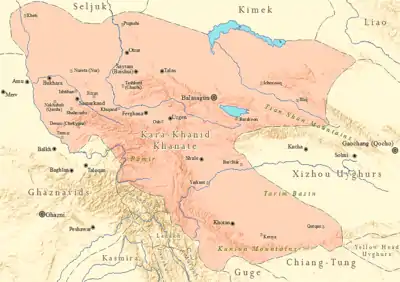
%252C_Emir_of_Bukhara%252C_photographed_by_S.M._Prokudin-Gorskiy_in_1911.jpg.webp)
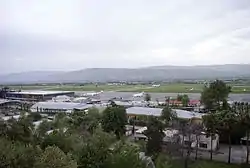
.jpg.webp)
.jpg.webp)
